Innovative Use of UHF-RFID Wireless Sensors for Monitoring Cultural Heritage Structures
Abstract
:1. Introduction
2. The RFID Technology
- A tag, which is composed of an antenna and an integrated circuit (IC) that has simple memory and simple control logic functions and is packaged as a plastic or paper label. The tag is powered up by other elements of the system through an electric or magnetic field, then it is able to transmit the information that contains. Reading and writing are allowed in handling such information in the tag memory, which stores a unique identification code.
- The battery-less microchip inside the tag receives power through electromagnetic waves that are collected by the antenna of the RFID tag, then it allows the sending and receiving of the data contained in the memory by modulating the field back-scattered by the antenna.
- The reader, the device used to interrogate tags also reads and filters the information back-scattered from the tags. Readers can include their own antenna in an integrated structure or can use a distinct antenna.
- The management system (server, host computer) acts as an information interface between the reader and the network. It allows us to obtain all the available information associated with tagged objects, the identification codes of each tag, and to manage the whole system for the purposes of the use case.
3. Experimental Investigation of the Application of the UHF-RFID Tags for Structural Monitoring
3.1. Laboratory Tests: Monitoring the Tags Displacements under Out-of-Plane Action
3.2. Results of the Laboratory Experimental Tests
3.2.1. Results of the 1st Laboratory Test
3.2.2. Results of the 2nd Laboratory Test
- The displacements detected by the tags quite perfectly match the displacements imposed;
- The altered response of some tags is due to interference in the environment and also to the more distant position of the tags in relation to the reader’s antenna;
- Measurements are intrinsically affected by the built-in errors of the reader and by the errors that occur during the processing of the data received specifically the standard deviations of the phase’s values).
3.3. In Situ Experiments: Monitoring the Out-of-Plane Displacements of the Tags on Brick Walls
4. Results of the In Situ Experimental Tests
4.1. Test on the 1st Wall: Comparison between Wireless Tags Displacements and Displacements of the Wired Transducer
4.2. Test on the 2nd Wall: Comparison between Wireless Tags Displacements and Displacements of the Wired Transducer
5. Conclusions
- The response of the t in the laboratory environment was demonstrated to be very satisfactory, proving that the new application of wireless RFID tags for the monitoring of out-of-plane displacements is feasible and potentially very reliable.
- A weaker response of some t can be attributed to the intrinsic measurement errors of the reader itself and the errors in processing the received data (standard deviations of the calculated mean values of the phases) and to environmental interference together with the position of the tags with respect to the antenna.
- In situ experiments showed a weaker response of the t which registered displacements lower than those recorded by the wired transducer used as reference. The high presence of metal in the environment affected negatively the transmission of the electromagnetic signals, modifying the phases and consequently the indirect measurements of displacements. Unluckily, the position of the experimental set-ups necessarily near a metal wall of the building site contributed to negatively affecting the displacement results and the set-ups required steel frames to constrain the single walls and to fix the load cell.
- Technology limits related to environmental interference can be overcome in future research by using commercial UHF-RFID tags for the real-time monitoring of an existing masonry facade that does not need a steel frame and can potentially respond adequately and properly transmit the electromagnetic signal.
Author Contributions
Funding
Data Availability Statement
Conflicts of Interest
Abbreviations
| UHF-RFID | Ultra High-Frequency-Radio Frequency Identification |
| SHM | Structural Health Monitoring |
| WSNs | Wireless Sensor Networks |
| IC | Integrated Circuit |
| PET | Polyethylene terephthalate (polyester) |
| EPC | Electronic Product Code |
| RSSI | Received Signal Strength Indicator |
References
- Stepinski, T.; Uhl, T.; Staszewski, W. Advanced Structural Damage Detection: From Theory to Engineering Applications; John Wiley & Sons, Inc.: Hoboken, NJ, USA, 2013. [Google Scholar] [CrossRef]
- Gomes, G.F.; Mendéz, Y.A.D.; Alexandrino, P.d.S.L.; da Cunha, S.S., Jr.; Ancelotti, A.C., Jr. The use of intelligent computational tools for damage detection and identification with an emphasis on composites—A review. Compos. Struct. 2018, 196, 44–54. [Google Scholar] [CrossRef]
- dos Santos, J.A.; Maia, N.; Soares, C.M.; Soares, C.M. Structural damage identification: A survey. Trends Comput. Struct. Technol. 2008, 1, 1–24. [Google Scholar] [CrossRef]
- Kong, X.; Cai, C.S.; Hu, J. The state-of-the-art on framework of vibration-based structural damage identification for decision making. Appl. Sci. 2017, 7, 497. [Google Scholar] [CrossRef]
- Li, Y. Hypersensitivity of strain-based indicators for structural damage identification: A review. Mech. Syst. Signal Process. 2010, 24, 653–664. [Google Scholar] [CrossRef]
- Wang, S.; Xu, M. Modal strain energy-based structural damage identification: A review and comparative study. Struct. Eng. Int. 2019, 29, 234–248. [Google Scholar] [CrossRef]
- Alba-Rodríguez, M.D.; Martínez-Rocamora, A.; González-Vallejo, P.; Ferreira-Sánchez, A.; Marrero, M. Building rehabilitation versus demolition and new construction: Economic and environmental assessment. Environ. Impact Assess. Rev. 2017, 66, 115–126. [Google Scholar] [CrossRef]
- Munarim, U.; Ghisi, E. Environmental feasibility of heritage buildings rehabilitation. Renew. Sustain. Energy Rev. 2016, 58, 235–249. [Google Scholar] [CrossRef]
- Hodge, V.J.; O’Keefe, S.; Weeks, M.; Moulds, A. Wireless sensor networks for condition monitoring in the railway industry: A survey. IEEE Trans. Intell. Transp. Syst. 2014, 16, 1088–1106. [Google Scholar] [CrossRef]
- Zhang, R.; Wood, J.; Young, C.; Taylor, A.; Balint, D.; Charalambides, M. A numerical investigation of interfacial and channelling crack growth rates under low-cycle fatigue in bi-layer materials relevant to cultural heritage. J. Cult. Herit. 2021, 49, 70–78. [Google Scholar] [CrossRef]
- Li, H.N.; Ren, L.; Jia, Z.G.; Yi, T.H.; Li, D.S. State-of-the-art in structural health monitoring of large and complex civil infrastructures. J. Civ. Struct. Health Monit. 2016, 6, 3–16. [Google Scholar] [CrossRef]
- Seo, J.; Hu, J.W.; Lee, J. Summary Review of Structural Health Monitoring Applications for Highway Bridges. J. Perform. Constr. Facil. 2016, 30, 824. [Google Scholar] [CrossRef]
- Kulkarni, S.S.; Achenbach, J.D. Structural health monitoring and damage prognosis in fatigue. Struct. Health Monit. 2008, 7, 37–49. [Google Scholar] [CrossRef]
- Dissanayake, P.; Karunananda, P. Reliability Index for Structural Health Monitoring of Aging Bridges. Struct. Health Monit. 2008, 7, 175–183. [Google Scholar] [CrossRef]
- Rivard, P.; Ballivy, G.; Gravel, C.; Saint-Pierre, F. Monitoring of an hydraulic structure affected by ASR: A case study. Cem. Concr. Res. 2010, 40, 676–680. [Google Scholar] [CrossRef]
- Anas, S.; Alam, M.; Shariq, M. Damage response of conventionally reinforced two-way spanning concrete slab under eccentric impacting drop weight loading. Def. Technol. 2023, 19, 12–34. [Google Scholar] [CrossRef]
- Anas, S.; Alam, M.; Umair, M. Experimental and numerical investigations on performance of reinforced concrete slabs under explosive-induced air-blast loading: A state-of-the-art review. Structures 2021, 31, 428–461. [Google Scholar] [CrossRef]
- Song, G.; Wang, C.; Wang, B. Structural Health Monitoring (SHM) of Civil Structures. Appl. Sci. 2017, 7, 789. [Google Scholar] [CrossRef]
- Kaloop, M.R.; Kim, D. GPS-structural health monitoring of a long span bridge using neural network adaptive filter. Surv. Rev. 2014, 46, 7–14. [Google Scholar] [CrossRef]
- Guzman-Acevedo, G.M.; Vazquez-Becerra, G.E.; Millan-Almaraz, J.R.; Rodriguez-Lozoya, H.E.; Reyes-Salazar, A.; Gaxiola-Camacho, J.R.; Martinez-Felix, C.A. GPS, Accelerometer, and Smartphone Fused Smart Sensor for SHM on Real-Scale Bridges. Adv. Civ. Eng. 2019, 2019, 15. [Google Scholar] [CrossRef]
- Kong, Q.; Allen, R.M.; Kohler, M.D.; Heaton, T.H.; Bunn, J. Structural Health Monitoring of Buildings Using Smartphone Sensors. Seismol. Res. Lett. 2018, 89, 594–602. [Google Scholar] [CrossRef]
- Sivasuriyan, A.; Vijayan, D.S.; Górski, W.; Wodzyński, Ł.; Vaverková, M.D.; Koda, E. Practical Implementation of Structural Health Monitoring in Multi-Story Buildings. Buildings 2021, 11, 263. [Google Scholar] [CrossRef]
- Lynch, J.P. An overview of wireless structural health monitoring for civil structures. Philos. Trans. R. Soc. Math. Phys. Eng. Sci. 2007, 365, 345–372. [Google Scholar] [CrossRef] [PubMed]
- Lynch, J.P.; Loh, K.J. A summary review of wireless sensors and sensor networks for structural health monitoring. Shock Vib. Dig. 2006, 38, 91–130. [Google Scholar] [CrossRef]
- Abdulkarem, M.; Samsudin, K.; Rokhani, F.Z.; A Rasid, M.F. Wireless sensor network for structural health monitoring: A contemporary review of technologies, challenges, and future direction. Struct. Health Monit. 2020, 19, 693–735. [Google Scholar] [CrossRef]
- Sofi, A.; Regita, J.J.; Rane, B.; Lau, H.H. Structural health monitoring using wireless smart sensor network—An overview. Mech. Syst. Signal Process. 2022, 163, 108113. [Google Scholar] [CrossRef]
- Huang, J.; He, L.; Xue, J.; Zhou, S.; Briseghella, B.; Castoro, C.; Aloisio, A.; Marano, G. Dynamic assessment of a stress-ribbon CFST arch bridge with SHM and NDE. In Life-Cycle of Structures and Infrastructure Systems; CRC Press: Boca Raton, FL, USA, 2023; pp. 2762–2769. [Google Scholar]
- He, L.; Castoro, C.; Aloisio, A.; Zhang, Z.; Marano, G.C.; Gregori, A.; Deng, C.; Briseghella, B. Dynamic assessment, FE modelling and parametric updating of a butterfly-arch stress-ribbon pedestrian bridge. Struct. Infrastruct. Eng. 2022, 18, 1064–1075. [Google Scholar] [CrossRef]
- Aygün, B.; Cagri Gungor, V. Wireless sensor networks for structure health monitoring: Recent advances and future research directions. Sens. Rev. 2011, 31, 261–276. [Google Scholar] [CrossRef]
- Ramos, L.F.; Aguilar, R.; Lourenço, P.B.; Moreira, S. Dynamic structural health monitoring of Saint Torcato church. Mech. Syst. Signal Process. 2013, 35, 1–15. [Google Scholar] [CrossRef]
- Pallarés, F.J.; Betti, M.; Bartoli, G.; Pallarés, L. Structural health monitoring (SHM) and Nondestructive testing (NDT) of slender masonry structures: A practical review. Constr. Build. Mater. 2021, 297, 123768. [Google Scholar] [CrossRef]
- Barsocchi, P.; Bartoli, G.; Betti, M.; Girardi, M.; Mammolito, S.; Pellegrini, D.; Zini, G. Wireless Sensor Networks for Continuous Structural Health Monitoring of Historic Masonry Towers. Int. J. Archit. Herit. 2020, 15, 22–44. [Google Scholar] [CrossRef]
- Roy, S.; Jandhyala, V.; Smith, J.R.; Wetherall, D.J.; Otis, B.P.; Chakraborty, R.; Buettner, M.; Yeager, D.J.; Ko, Y.C.; Sample, A.P. RFID: From supply chains to sensor nets. Proc. IEEE 2010, 98, 1583–1592. [Google Scholar] [CrossRef]
- Caizzone, S.; DiGiampaolo, E.; Marrocco, G. Wireless crack monitoring by stationary phase measurements from coupled RFID tags. IEEE Trans. Antennas Propag. 2014, 62, 6412–6419. [Google Scholar] [CrossRef]
- Caizzone, S.; DiGiampaolo, E. Wireless passive RFID crack width sensor for structural health monitoring. IEEE Sens. J. 2015, 15, 6767–6774. [Google Scholar] [CrossRef]
- Caizzone, S.; DiGiampaolo, E.; Marrocco, G. Constrained pole-zero synthesis of phase-oriented RFID sensor antennas. IEEE Trans. Antennas Propag. 2015, 64, 496–503. [Google Scholar] [CrossRef]
- DiNatale, A.; DiCarlofelice, A.; DiGiampaolo, E. A Crack Mouth Opening Displacement Gauge Made with Passive UHF RFID Technology. IEEE Sens. J. 2022, 22, 174–181. [Google Scholar] [CrossRef]
- Paggi, C.; Occhiuzzi, C.; Marrocco, G. Sub-millimeter displacement sensing by passive UHF RFID antennas. IEEE Trans. Antennas Propag. 2013, 62, 905–912. [Google Scholar] [CrossRef]
- DiGiampaolo, E.; DiCarlofelice, A.; Gregori, A. An RFID-Enabled Wireless Strain Gauge Sensor for Static and Dynamic Structural Monitoring. IEEE Sens. J. 2017, 17, 286–294. [Google Scholar] [CrossRef]
- Martínez-Martínez, J.J.; Herraiz-Martínez, F.J.; Galindo-Romera, G. A Contactless RFID System Based on Chipless MIW Tags. IEEE Trans. Antennas Propag. 2018, 66, 5064–5071. [Google Scholar] [CrossRef]
- Jayawardana, D.; Liyanapathirana, R.; Zhu, X. RFID-Based Wireless Multi-Sensory System for Simultaneous Dynamic Acceleration and Strain Measurements of Civil Infrastructure. IEEE Sens. J. 2019, 19, 12389–12397. [Google Scholar] [CrossRef]
- Wang, Q.; Zhang, C.; Ma, Z.; Jiao, G.; Jiang, X.; Ni, Y.; Wang, Y.; Du, Y.; Qu, G.; Huang, J. Towards long-transmission-distance and semi-active wireless strain sensing enabled by dual-interrogation-mode RFID technology. Struct. Control. Health Monit. 2022, 29. [Google Scholar] [CrossRef]
- Gregori, A.; DiGiampaolo, E.; DiCarlofelice, A.; Castoro, C. Presenting a New Wireless Strain Method for Structural Monitoring: Experimental Validation. J. Sensors 2019, 2019, 5370838. [Google Scholar] [CrossRef]
- Gregori, A.; Castoro, C.; DiNatale, A.; Mercuri, M.; DiGiampaolo, E. Using commercial UHF-RFID wireless tags to detect structural damage. Procedia Struct. Integr. 2023, 44, 1586–1593. [Google Scholar] [CrossRef]
- Liu, G.; Wang, Q.A.; Jiao, G.; Dang, P.; Nie, G.; Liu, Z.; Sun, J. Review of Wireless RFID Strain Sensing Technology in Structural Health Monitoring. Sensors 2023, 23, 6925. [Google Scholar] [CrossRef] [PubMed]
- Mercuri, M.; Pathirage, M.; Gregori, A.; Cusatis, G. Computational modeling of the out-of-plane behavior of unreinforced irregular masonry. Eng. Struct. 2020, 223, 111181. [Google Scholar] [CrossRef]
- Mercuri, M.; Pathirage, M.; Gregori, A.; Cusatis, G. On the collapse of the masonry Medici tower: An integrated discrete-analytical approach. Struct. Eng. Rev. 2021, 246, 113046. [Google Scholar] [CrossRef]
- Cecchi, A.; Sab, K. Out of plane model for heterogeneous periodic materials: The case of masonry. Eur. J. -Mech.-A/Solids 2002, 21, 715–746. [Google Scholar] [CrossRef]
- Smilović Zulim, M.; Radnić, J. Anisotropy Effect of Masonry on the Behaviour and Bearing Capacity of Masonry Walls. Adv. Mater. Sci. Eng. 2020, 2020, 5676901. [Google Scholar] [CrossRef]
- Dominici, D.; Galeota, D.; Gregori, A.; Rosciano, E.; Alicandro, M.; Elaiopoulos, M. Integrating geomatics and structural investigation in post-earthquake monitoring of ancient monumental Buildings. J. Appl. Geod. 2014, 8, 141–154. [Google Scholar] [CrossRef]
- Li, X.; Gao, G.; Zhu, H.; Li, Q.; Zhang, N.; Qi, Z. UHF RFID tag antenna based on the DLS-EBG structure for metallic objects. IET Microwaves Antennas Propag. 2020, 14, 567–572. [Google Scholar] [CrossRef]
- Moraru, A.; Ursachi, C.; Helerea, E. A New Washable UHF RFID Tag: Design, Fabrication, and Assessment. Sensors 2020, 20, 3451. [Google Scholar] [CrossRef]
- Wang, P.; Dong, L.; Wang, H.; Li, G.; Di, Y.; Xie, X.; Huang, D. Passive Wireless Dual-Tag UHF RFID Sensor System for Surface Crack Monitoring. Sensors 2021, 21, 882. [Google Scholar] [CrossRef] [PubMed]
- Erman, F.; Koziel, S.; Leifsson, L. Broadband/Dual-Band Metal-Mountable UHF RFID Tag Antennas: A Systematic Review, Taxonomy Analysis, Standards of Seamless RFID System Operation, Supporting IoT Implementations, Recommendations, and Future Directions. IEEE Internet Things J. 2023, 10, 14780–14797. [Google Scholar] [CrossRef]
- Zhu, X.; Mukhopadhyay, S.K.; Kurata, H. A review of RFID technology and its managerial applications in different industries. J. Eng. Technol. Manag. 2012, 29, 152–167. [Google Scholar] [CrossRef]
- Nambiar, A.N. RFID technology: A review of its applications. In Proceedings of the World Congress on Engineering and Computer Science, San Francisco, CA, USA, 20–22 October 2009; International Association of Engineers: Hong Kong, China, 2009; Volume 2, pp. 20–22. [Google Scholar]
- Kumar, P.; Reinitz, H.; Simunovic, J.; Sandeep, K.; Franzon, P. Overview of RFID technology and its applications in the food industry. J. Food Sci. 2009, 74, R101–R106. [Google Scholar] [CrossRef]
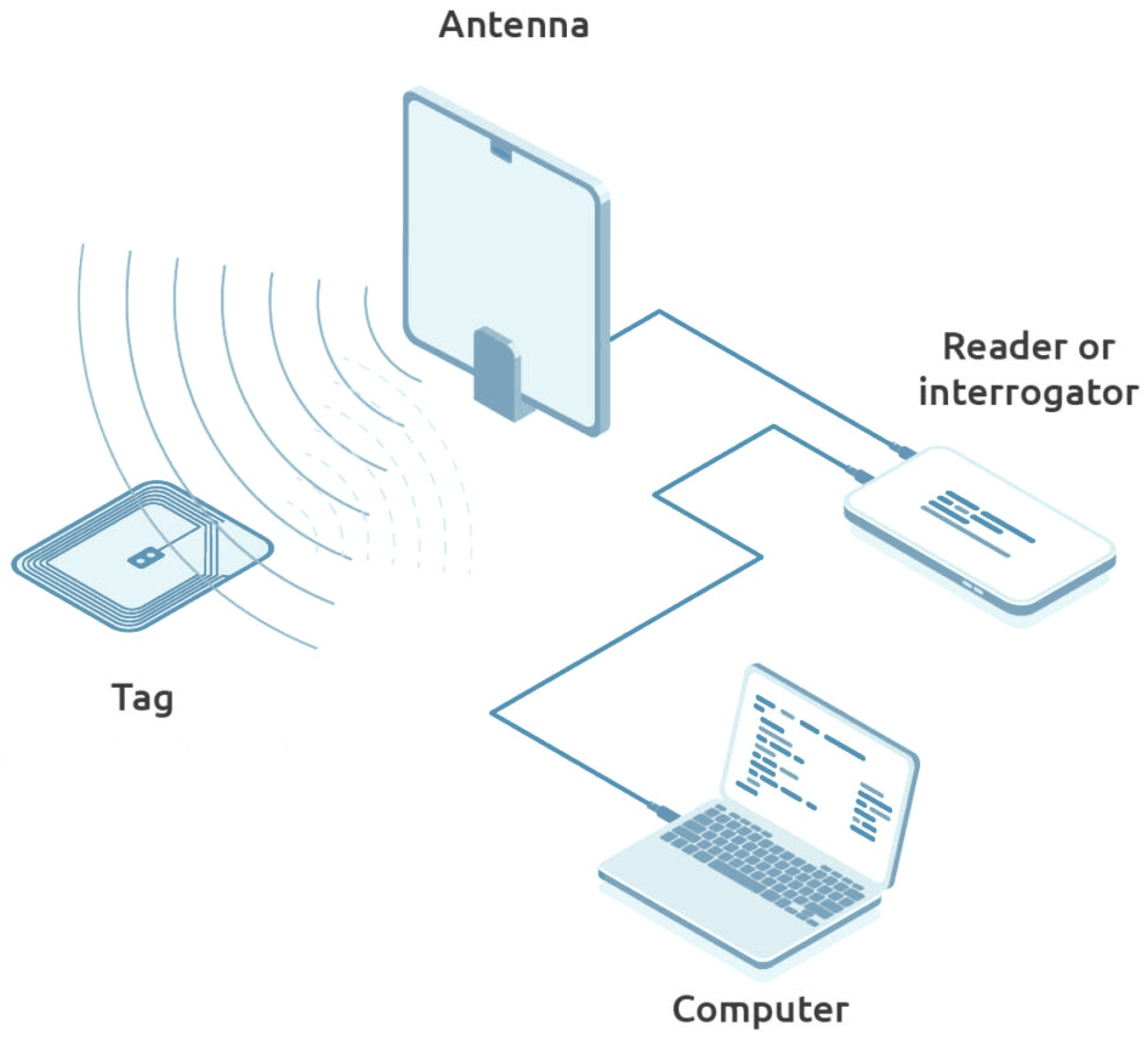
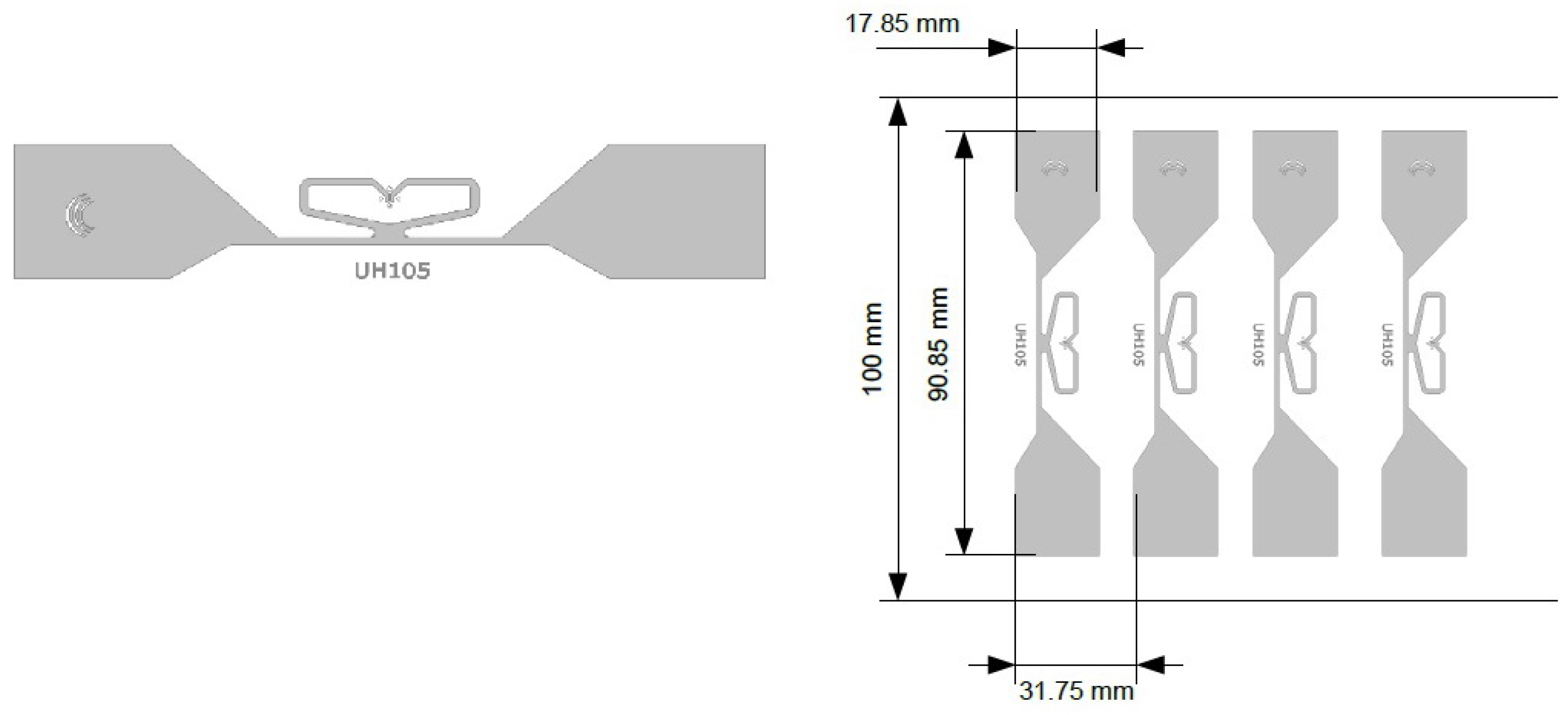

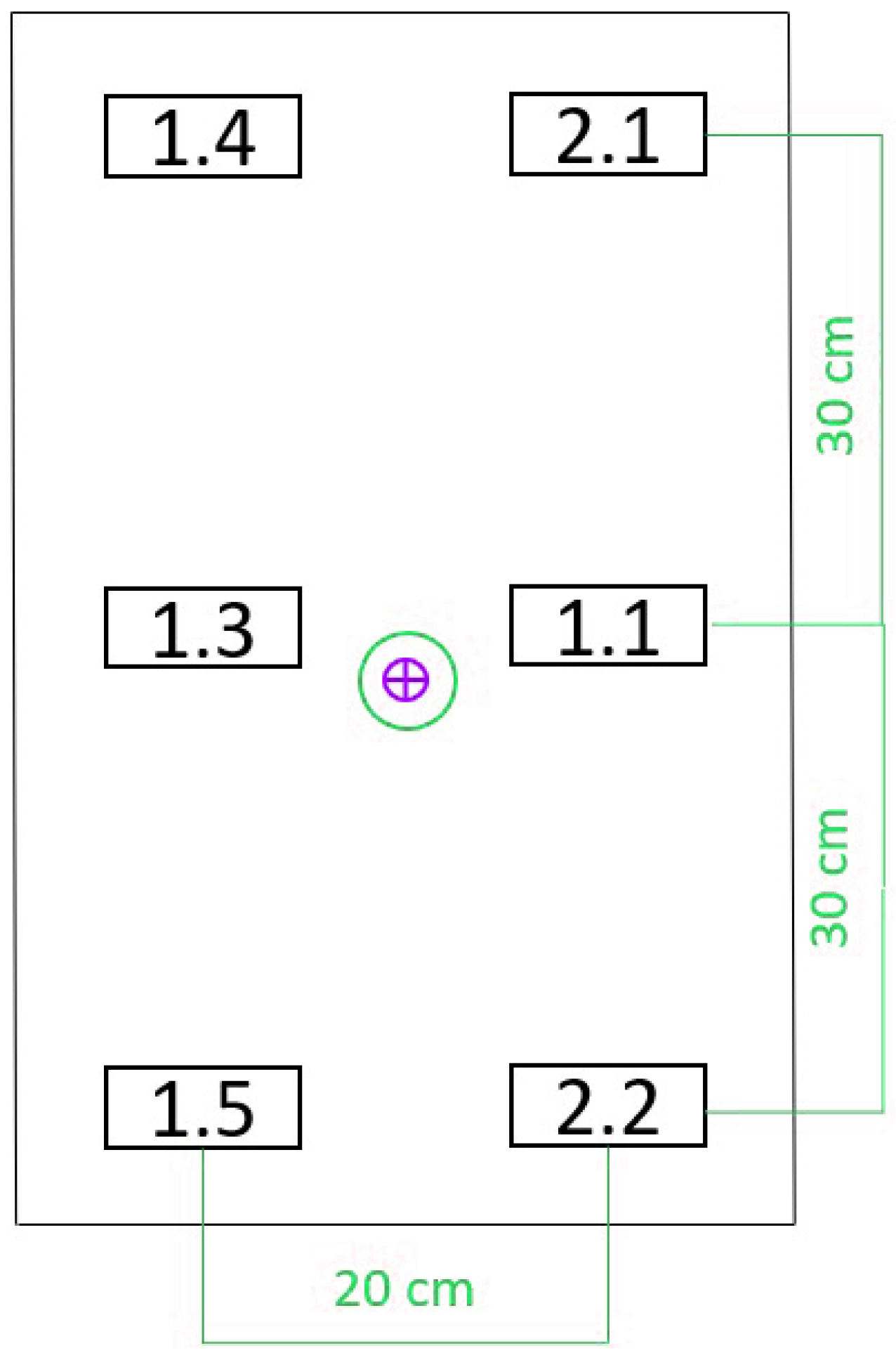




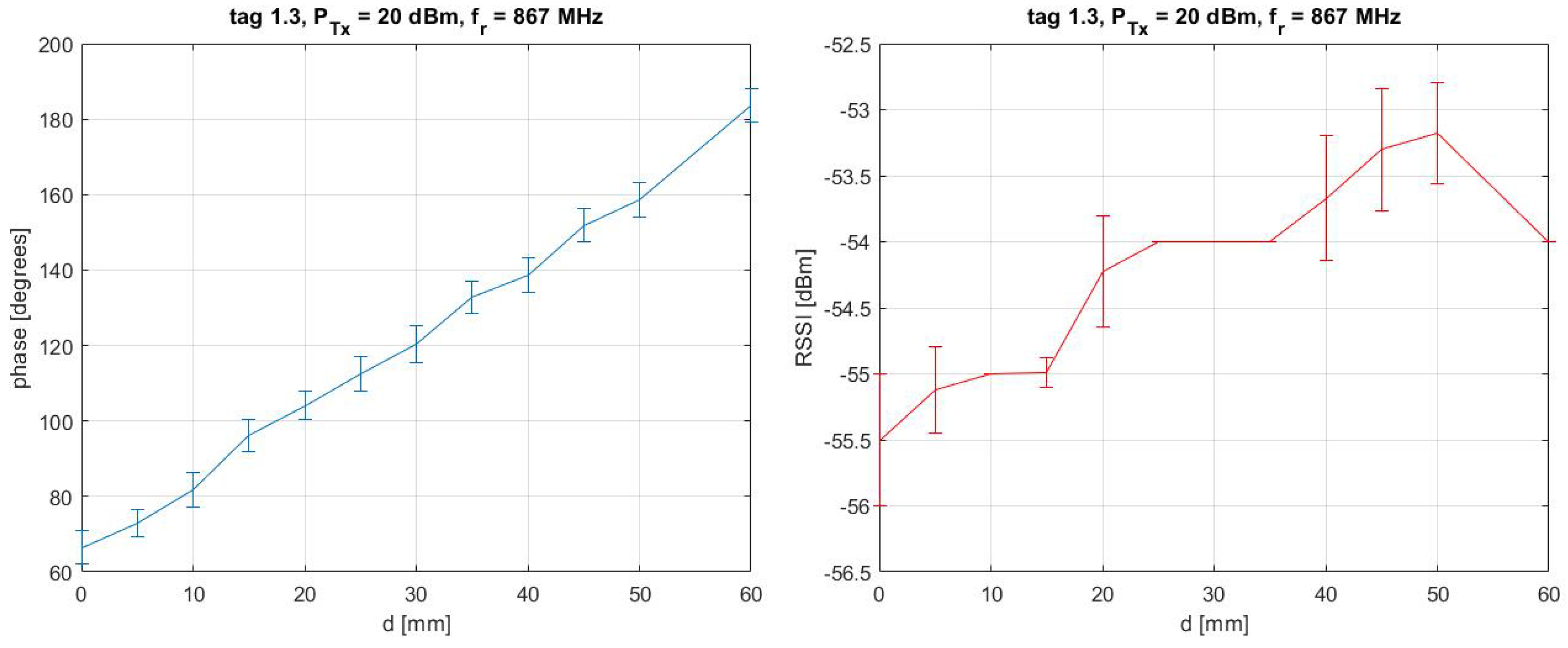
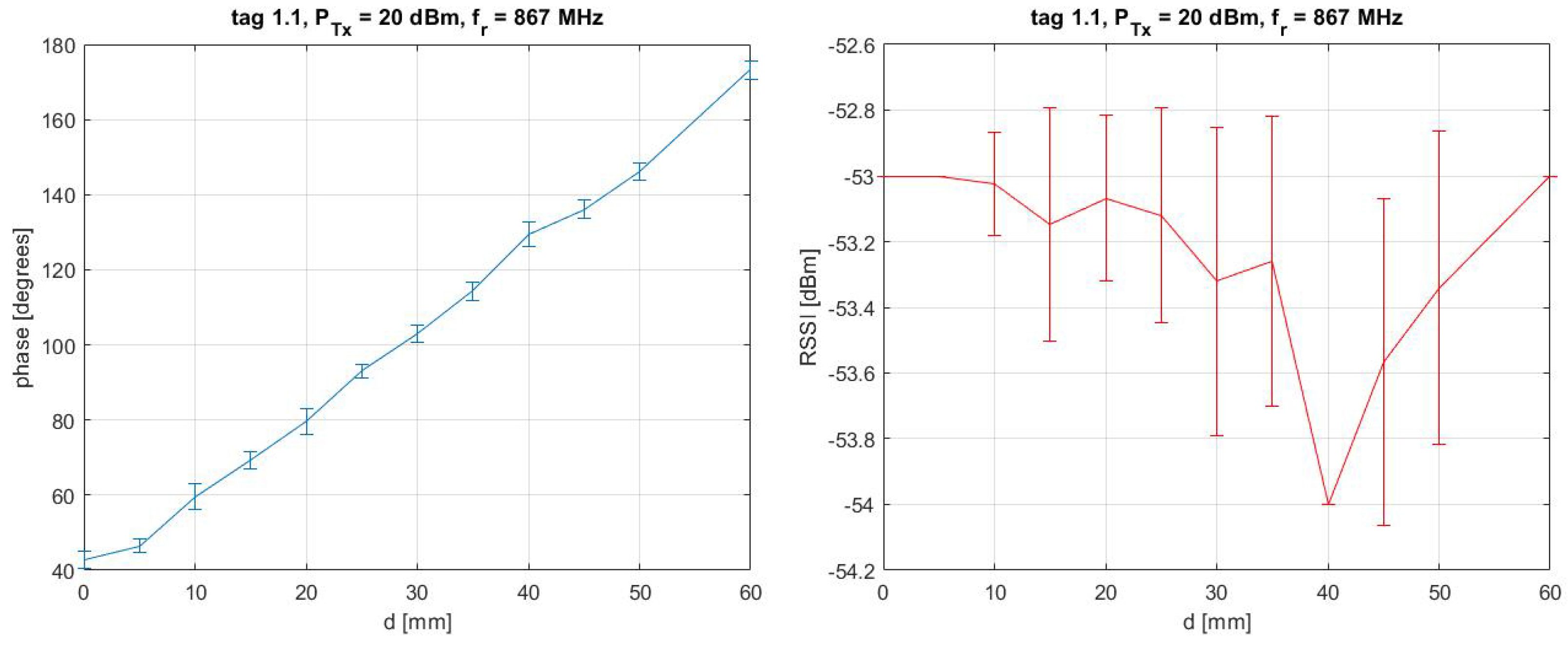

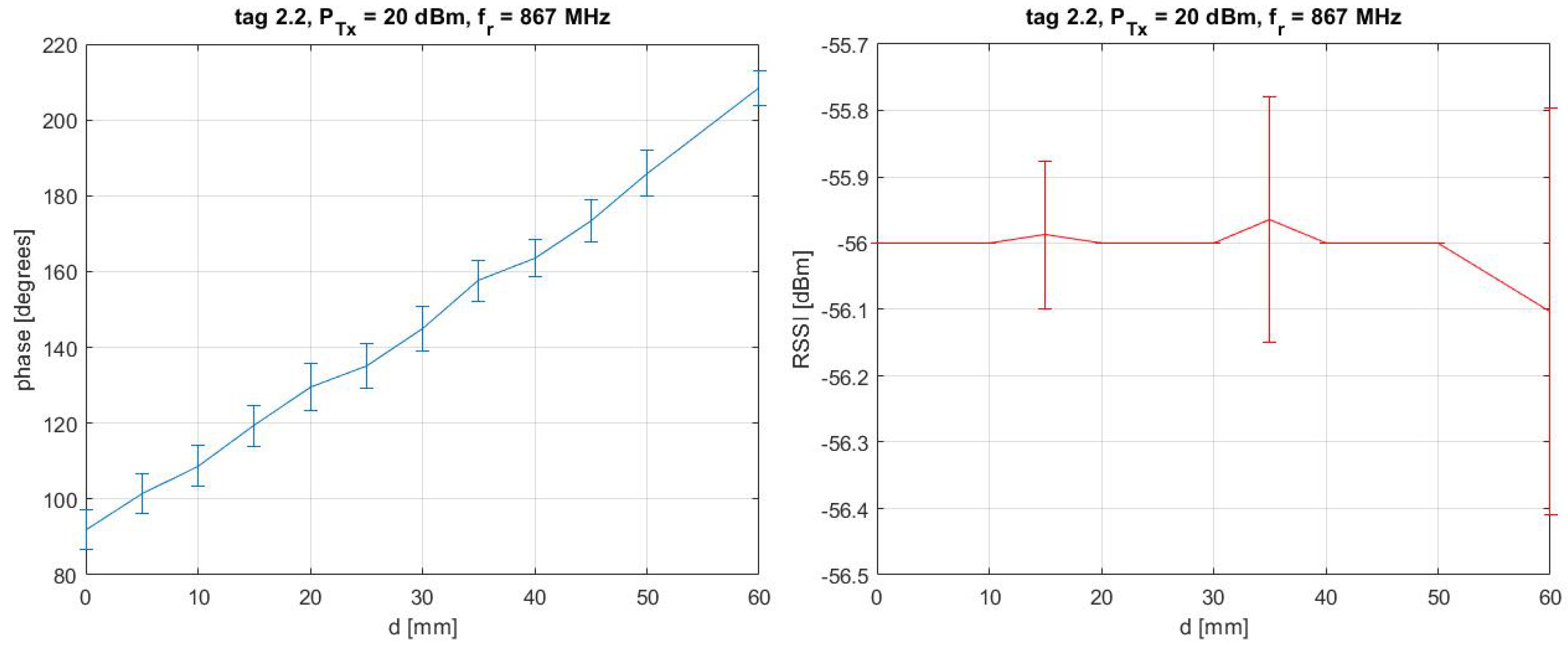
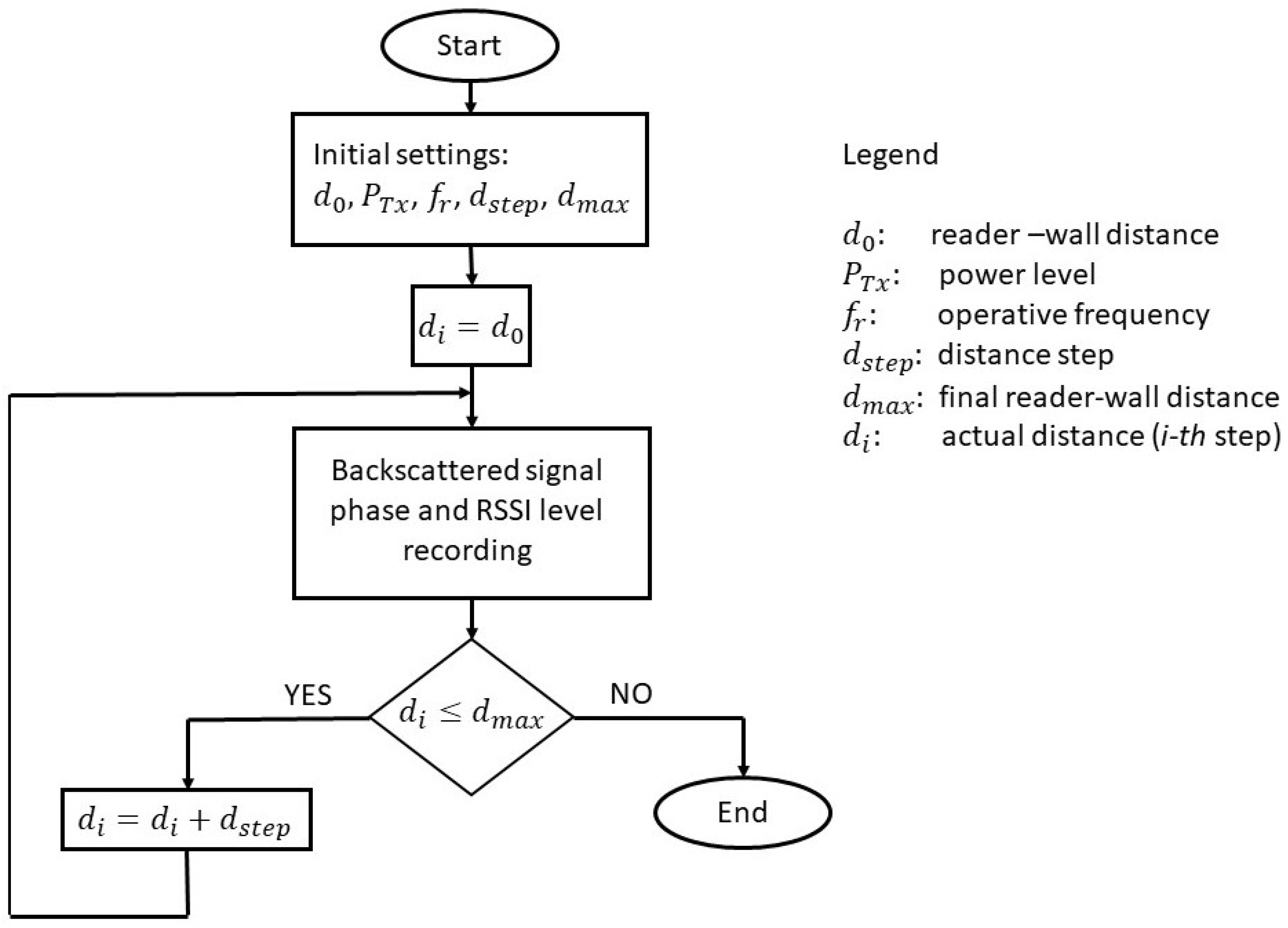
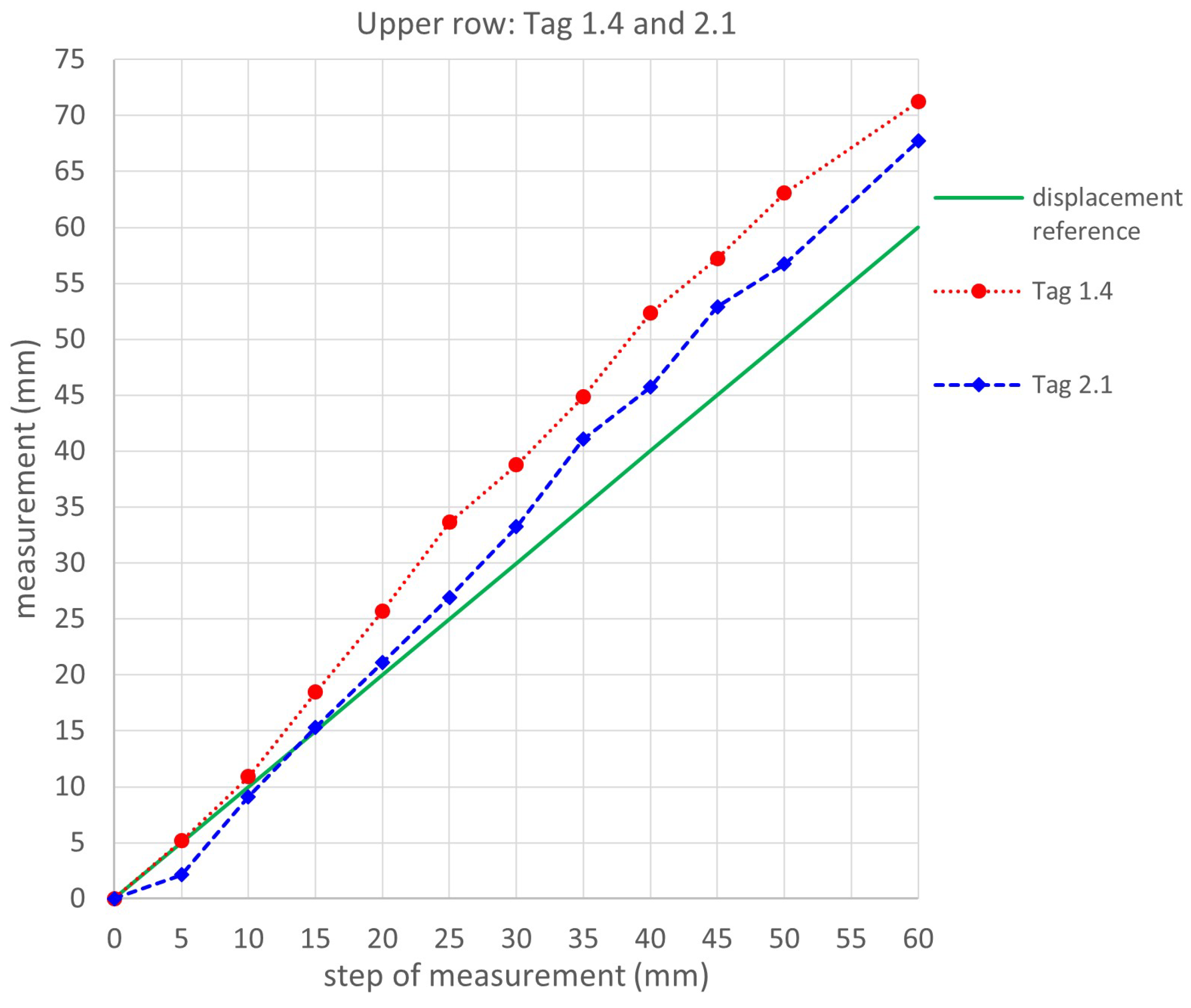
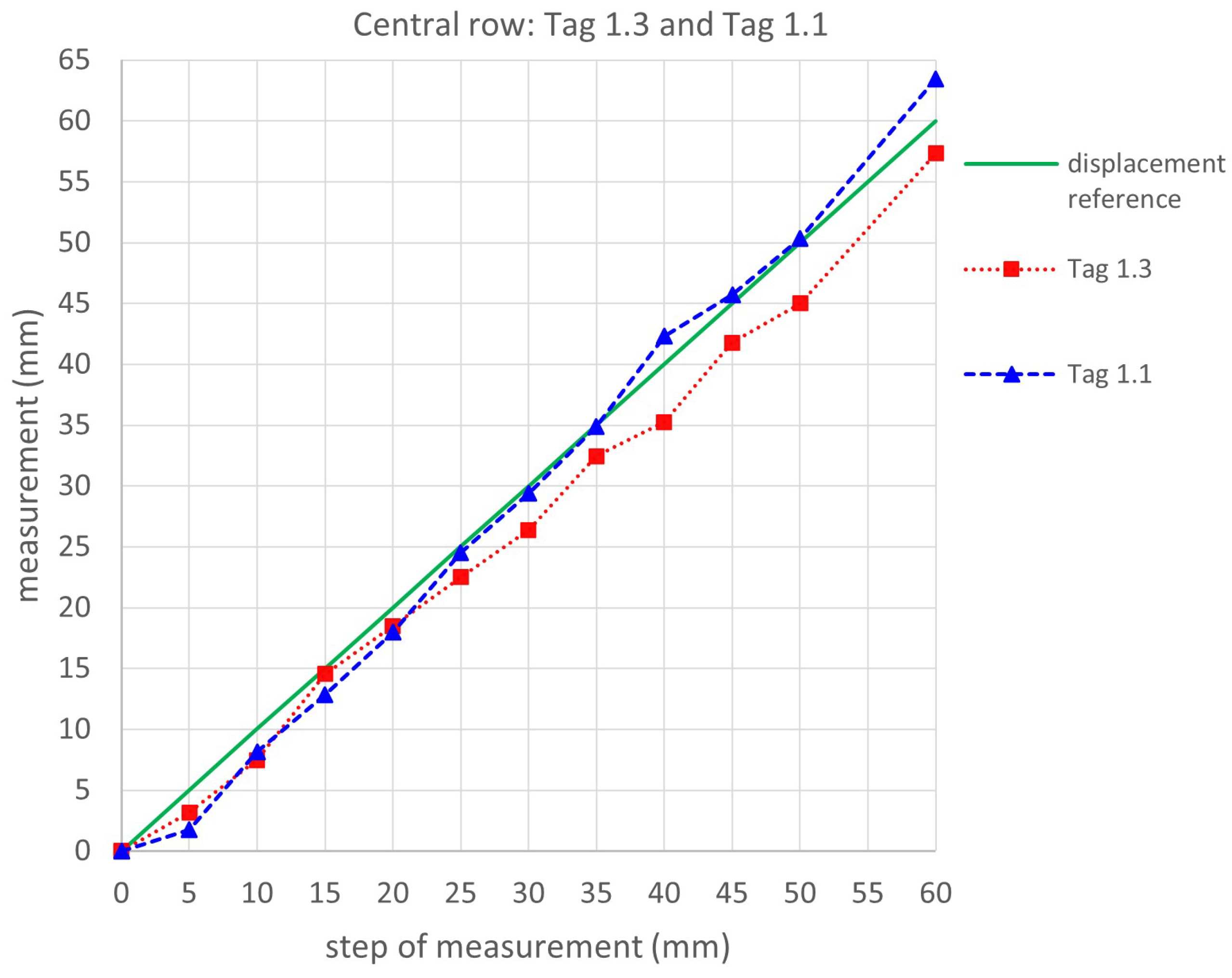
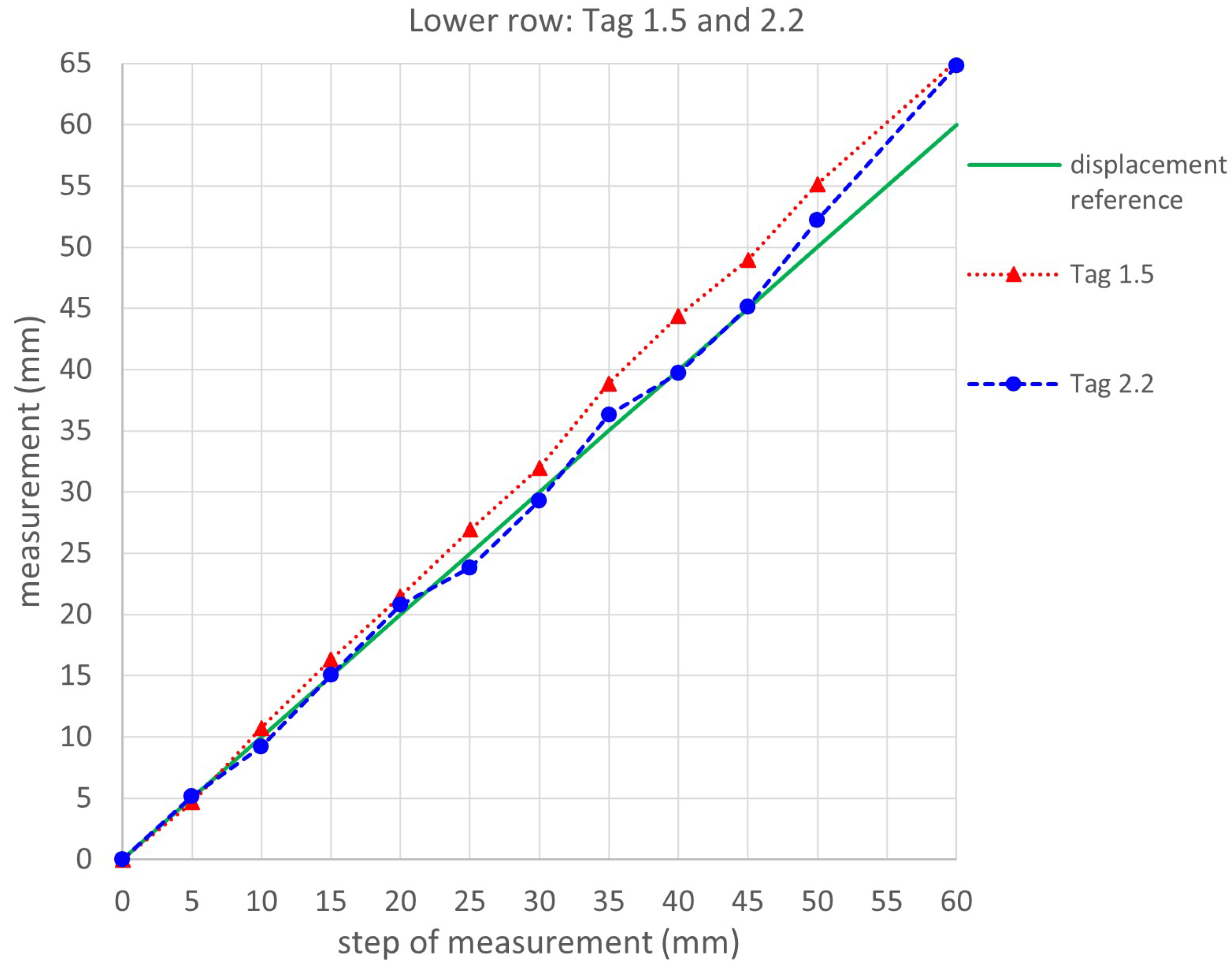

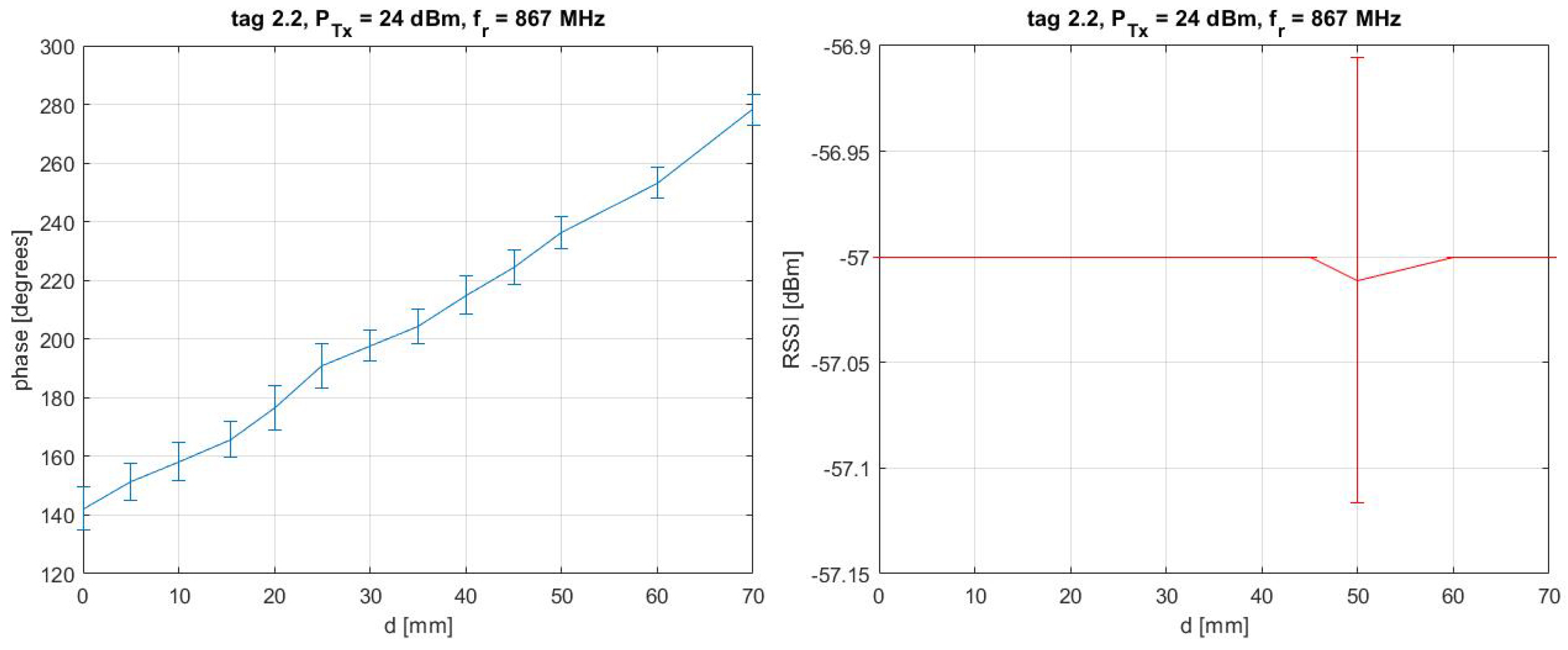
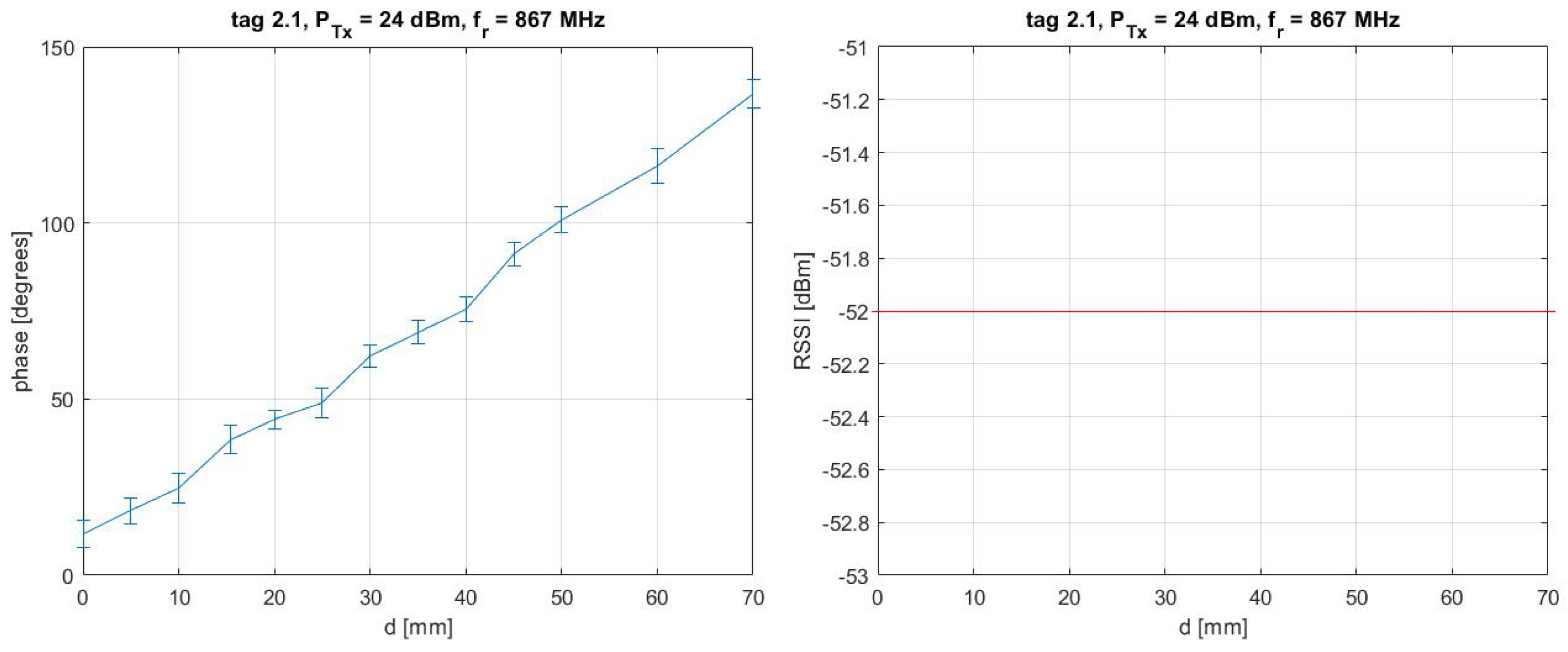

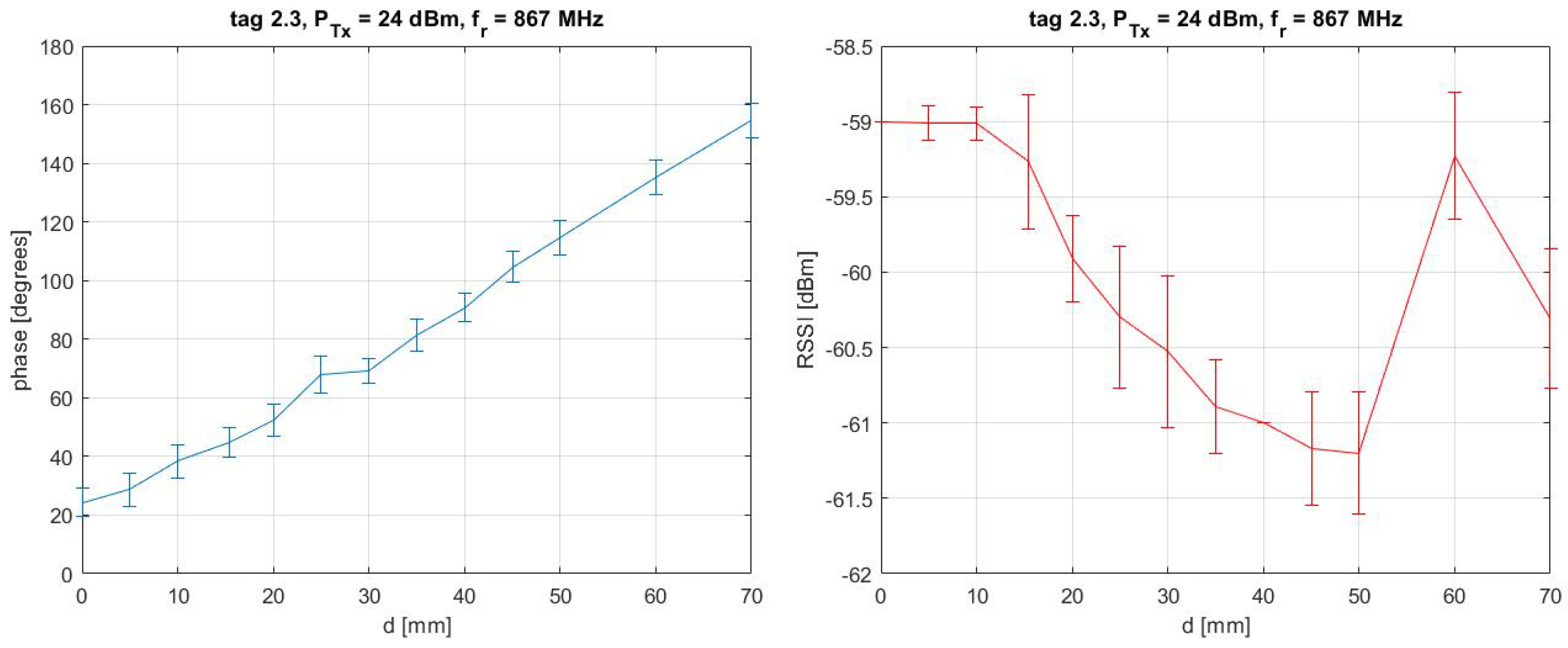



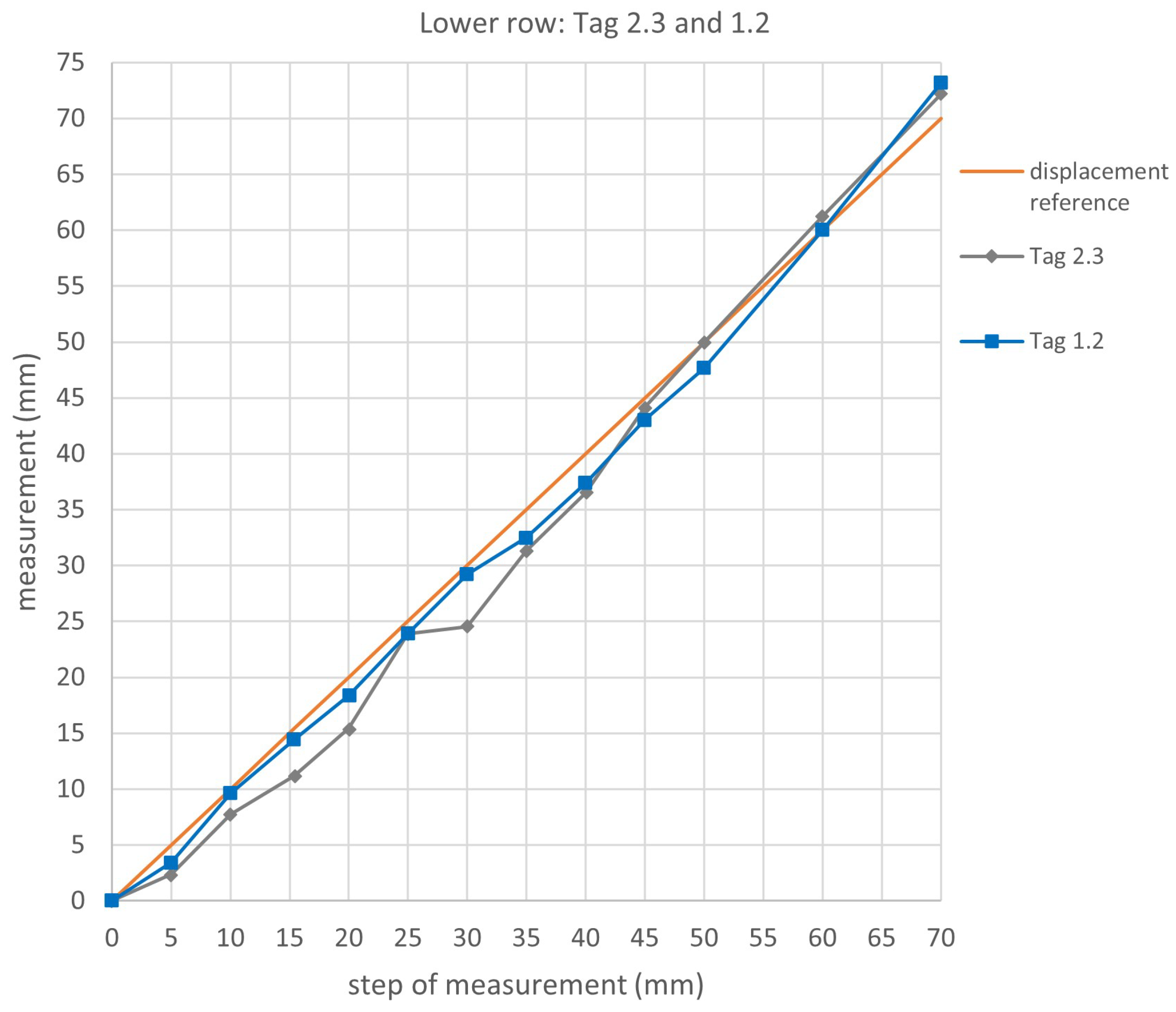
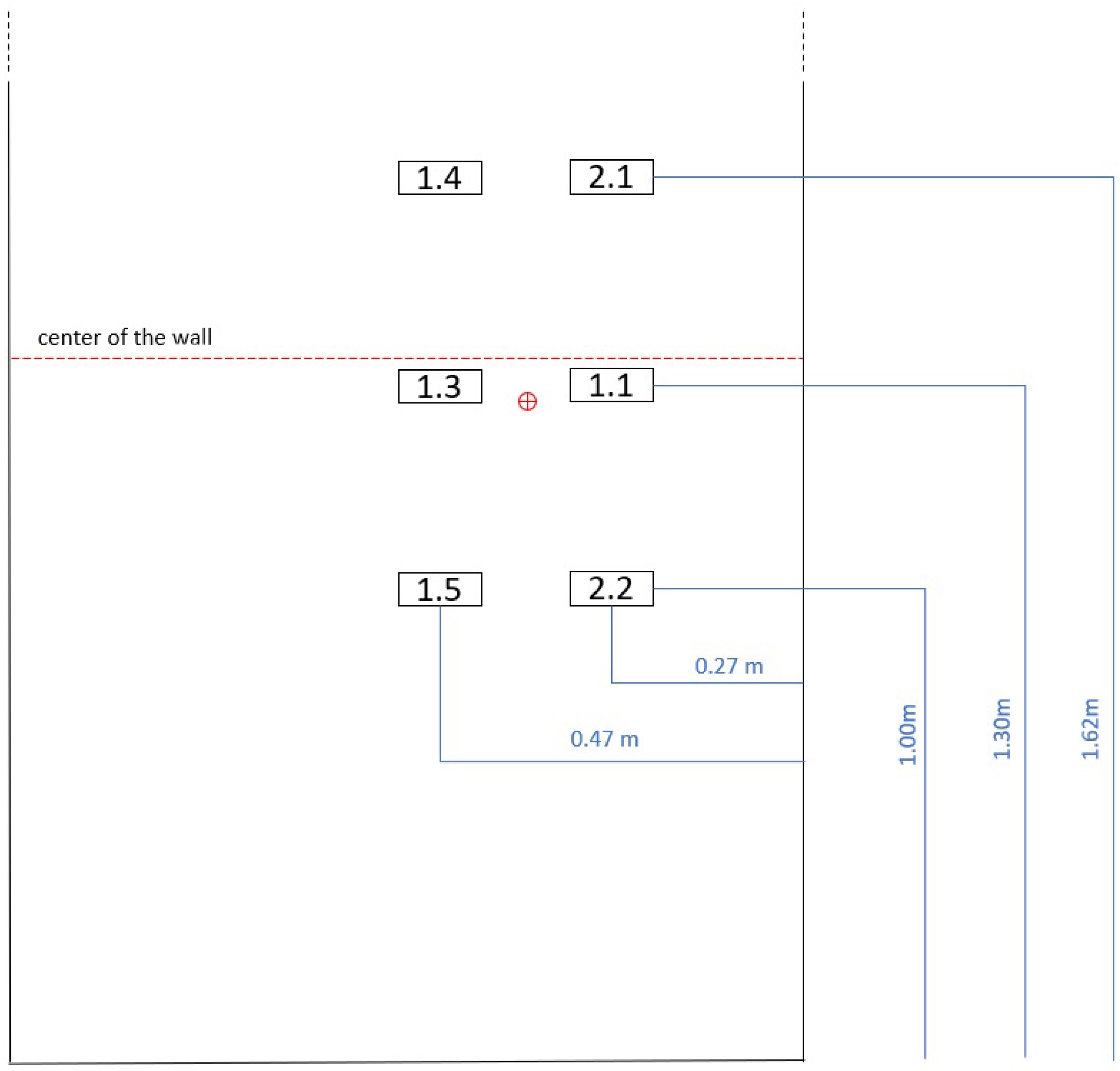
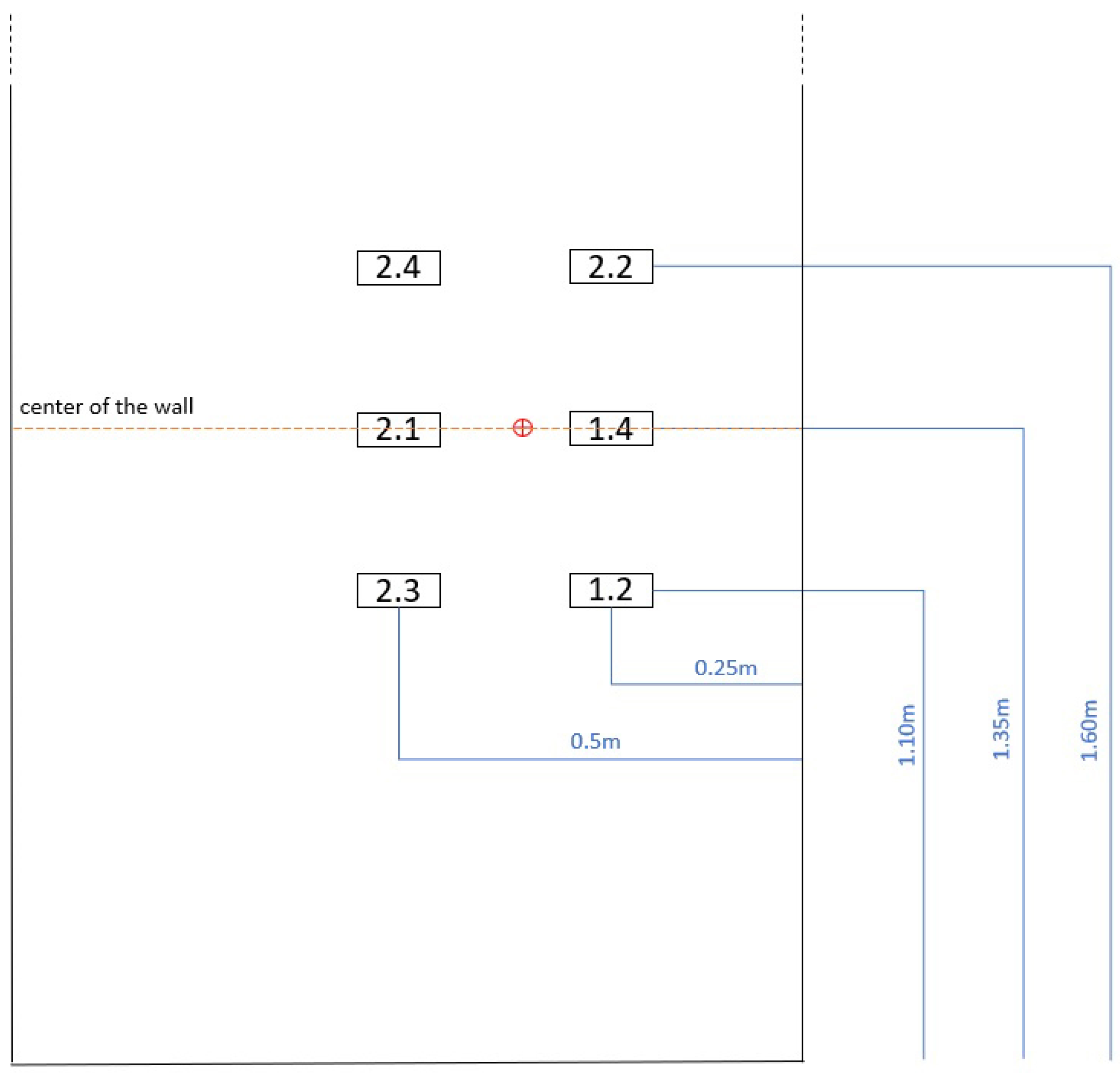


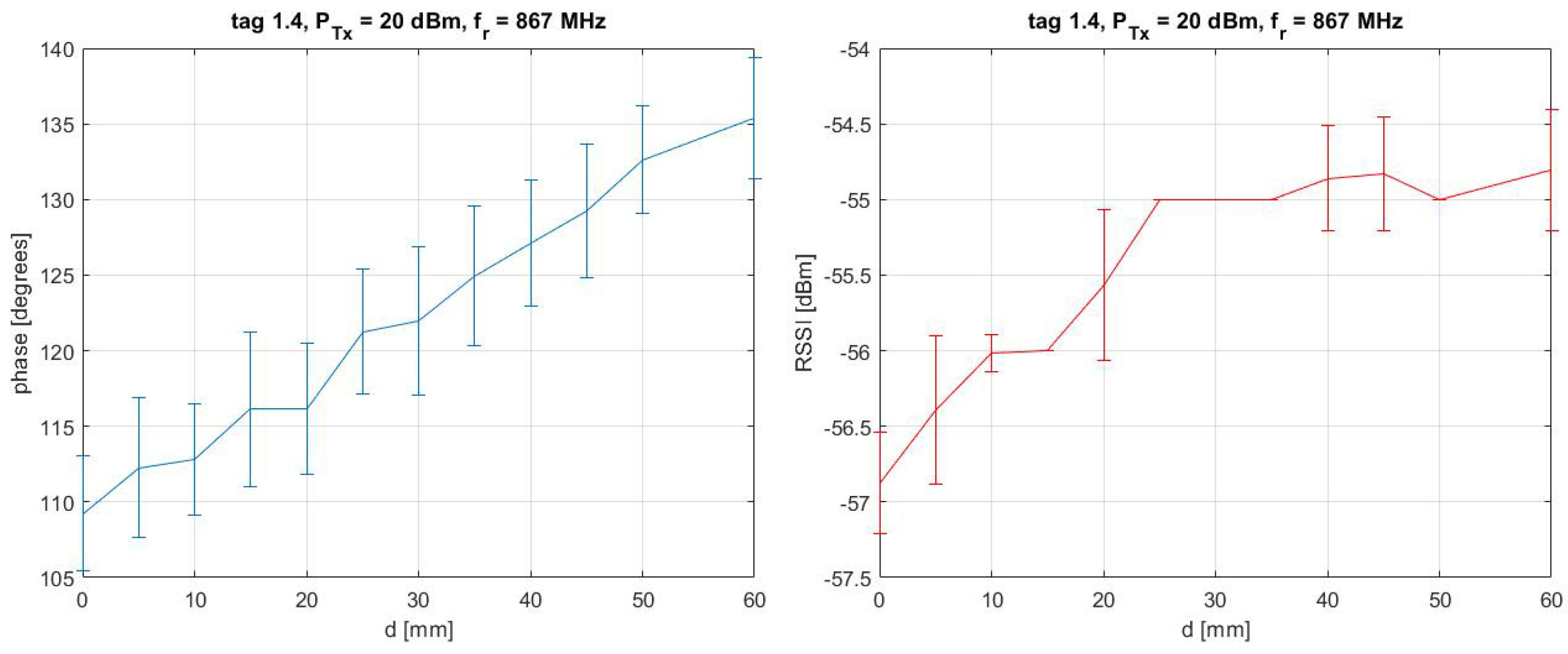


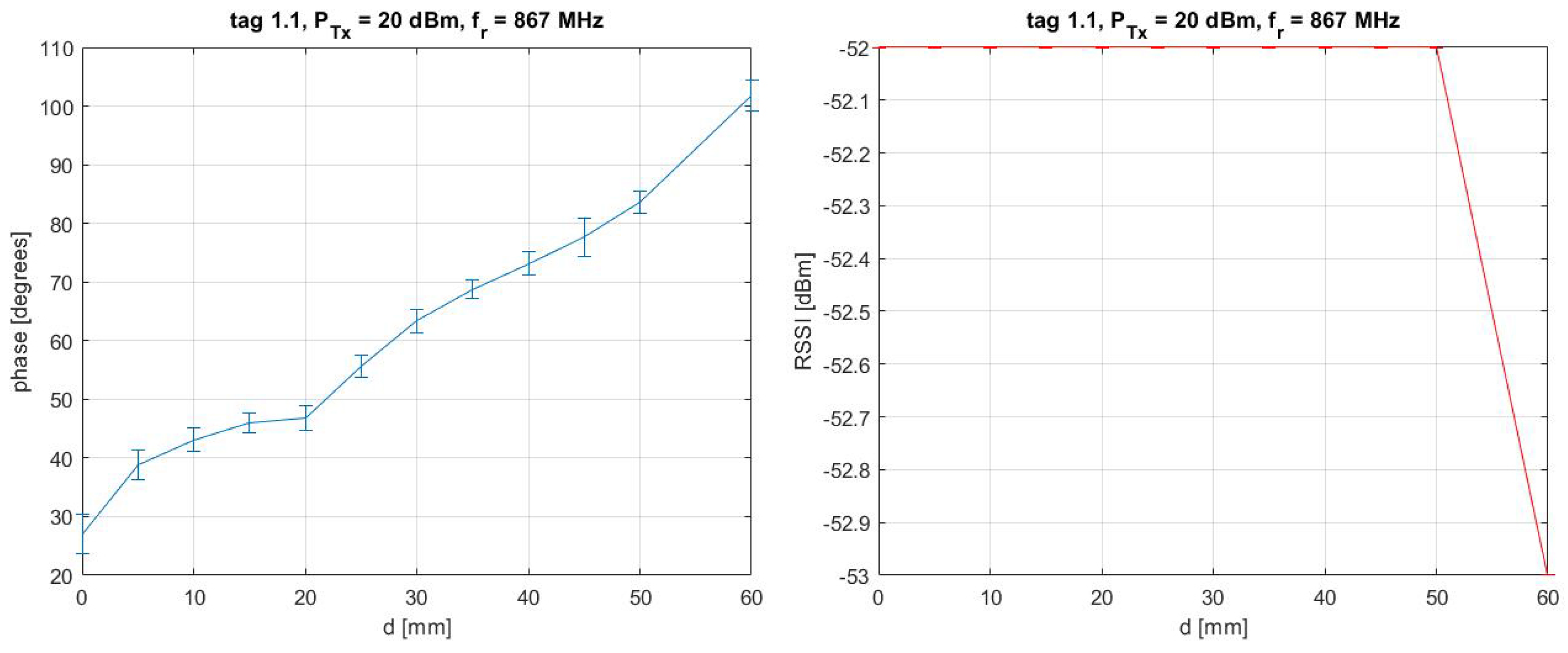
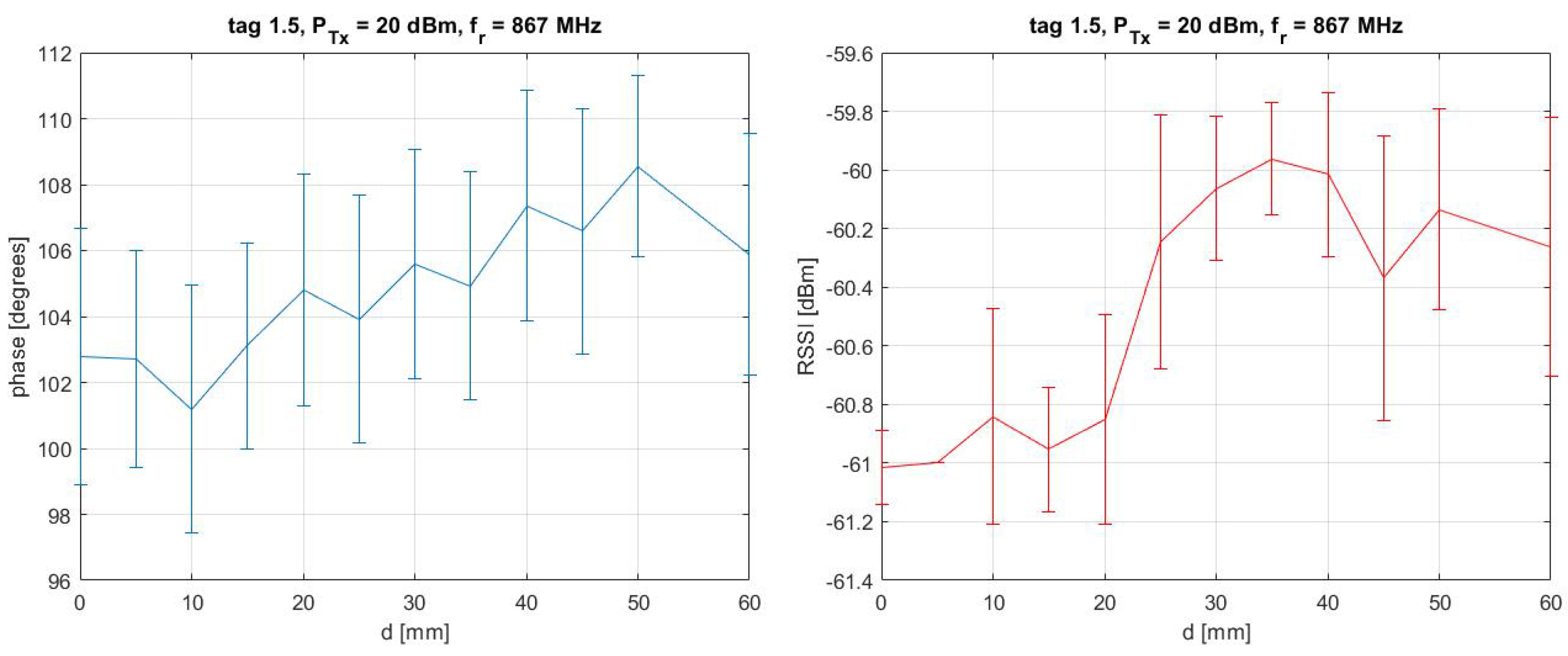
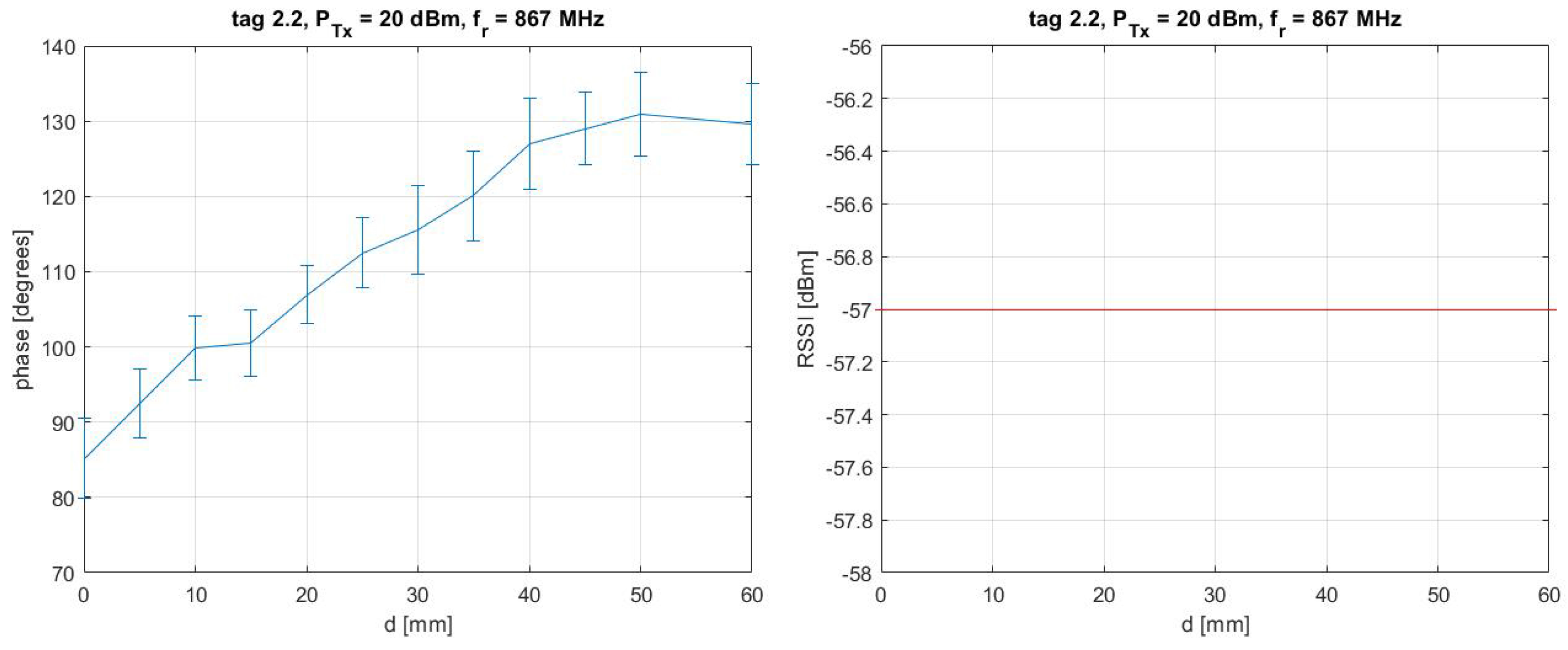
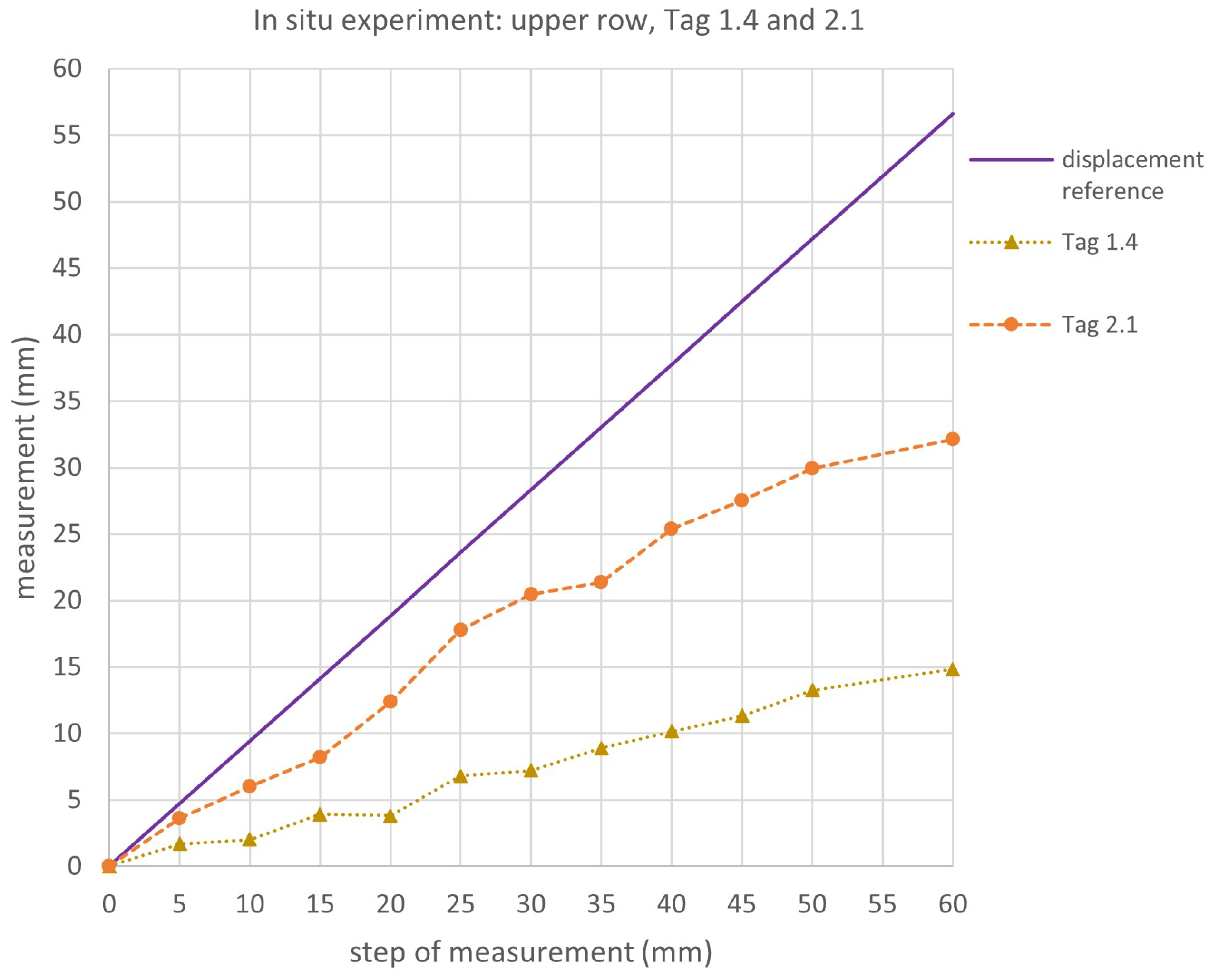
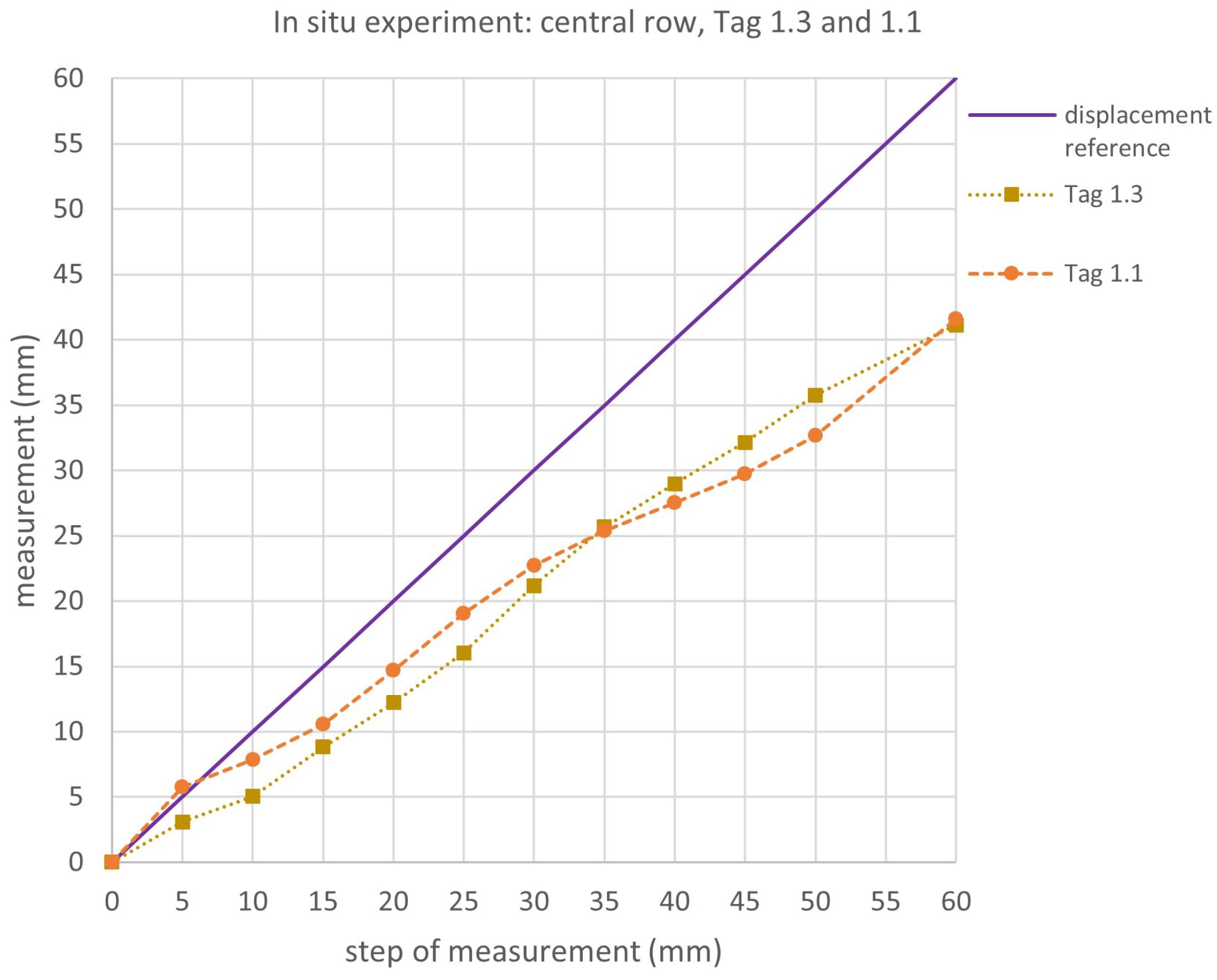


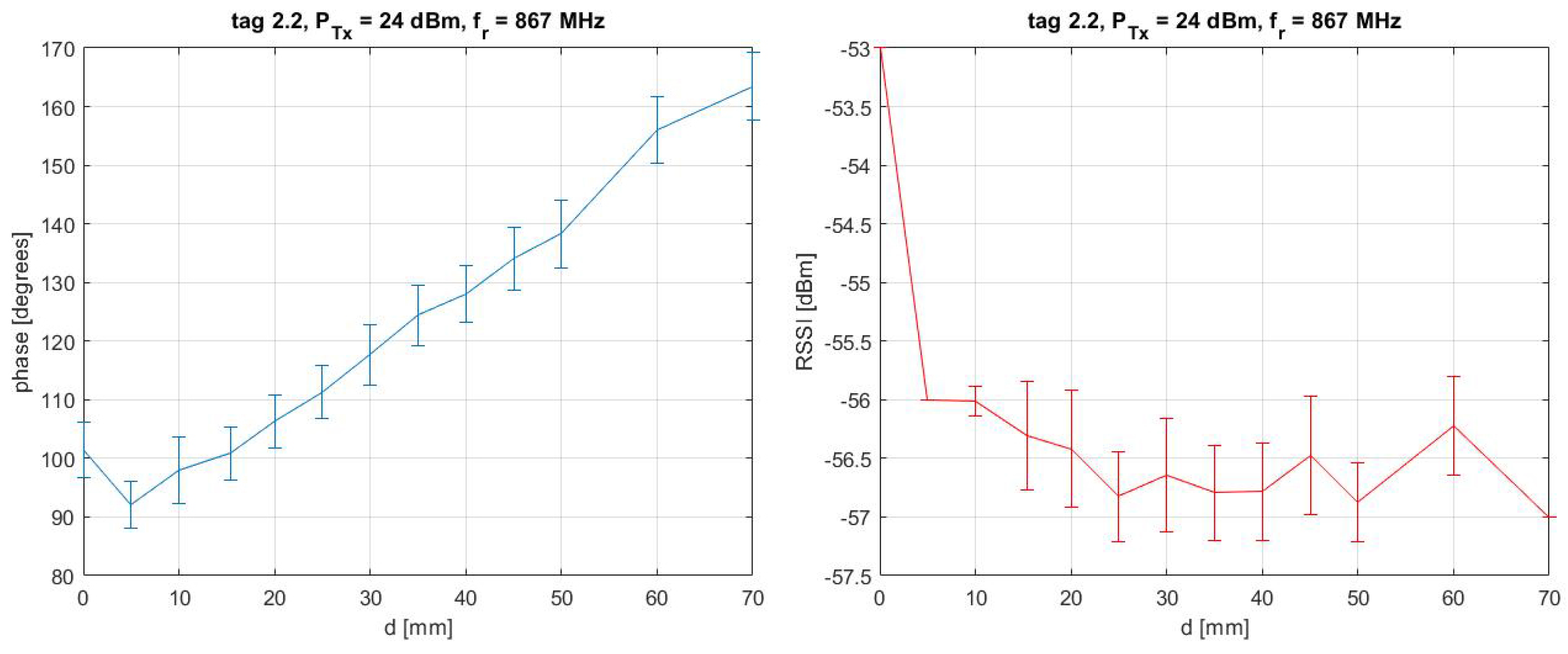

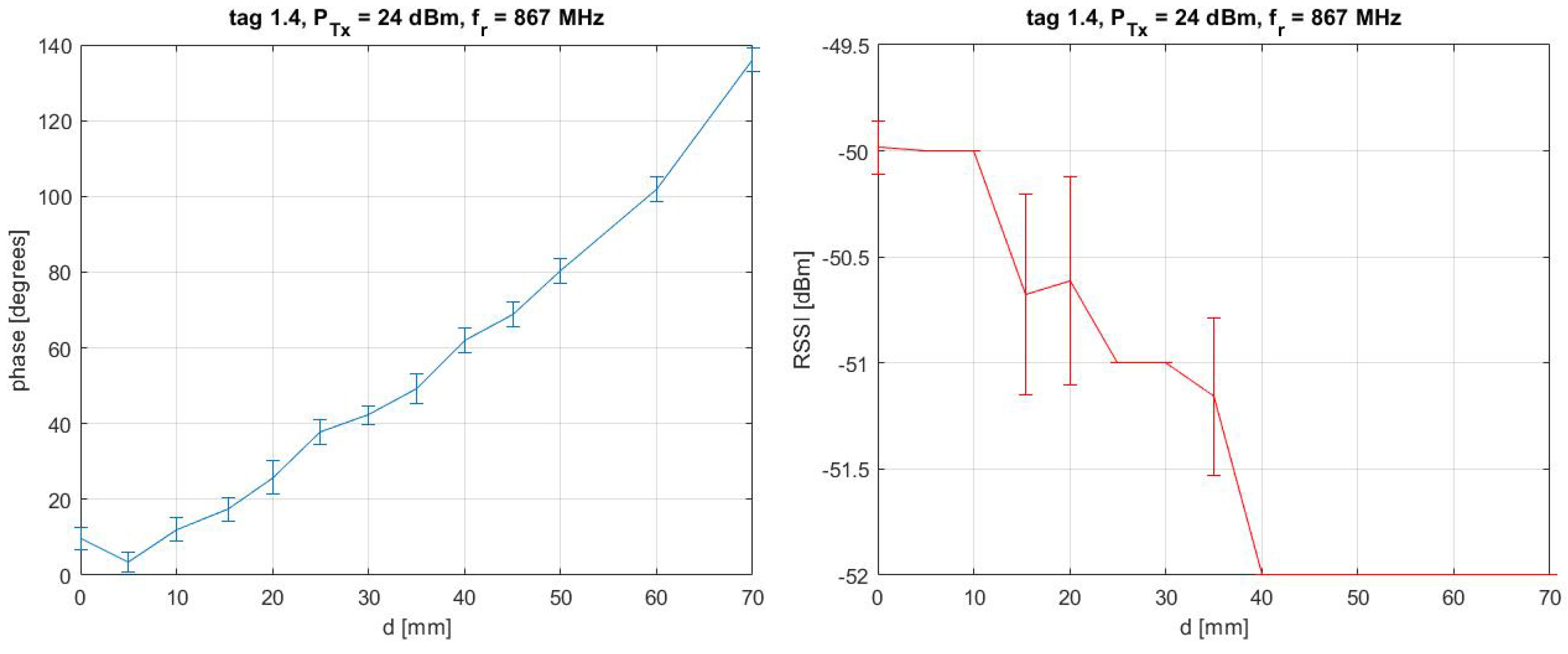
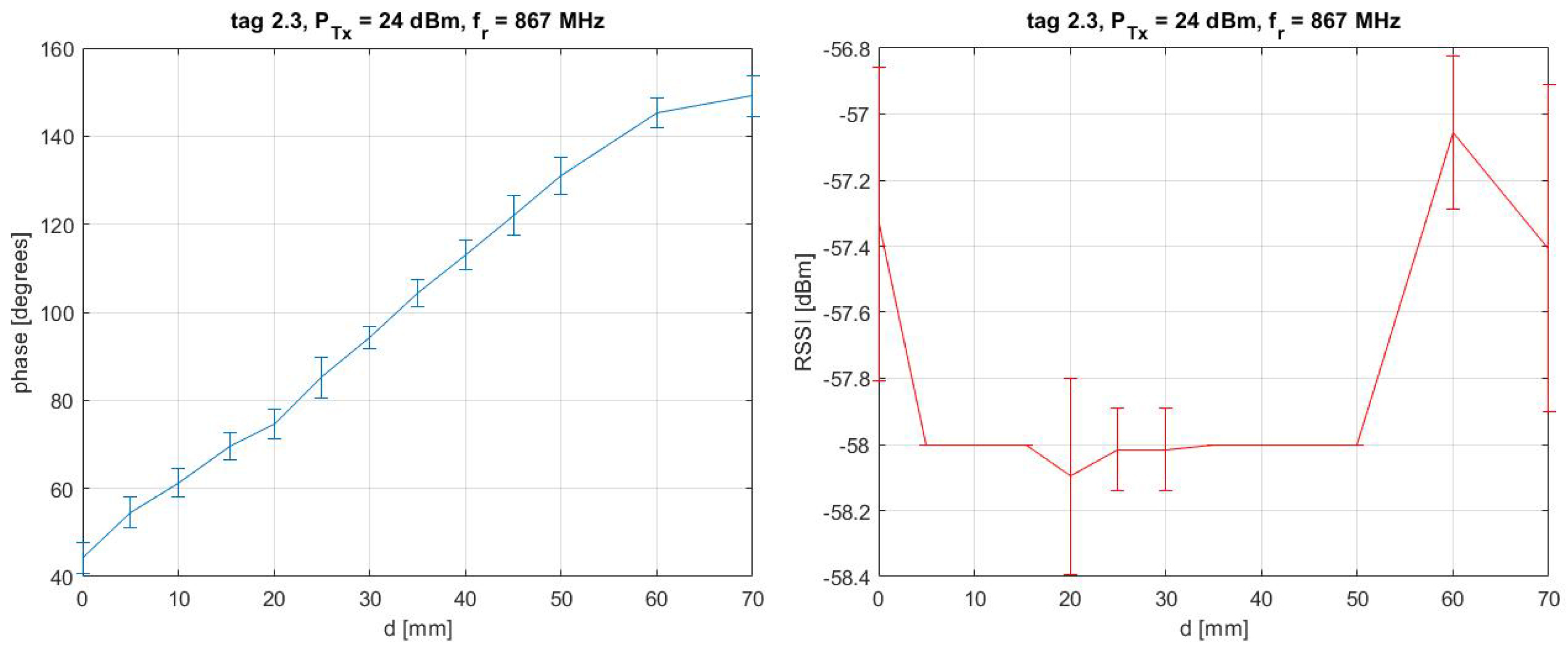
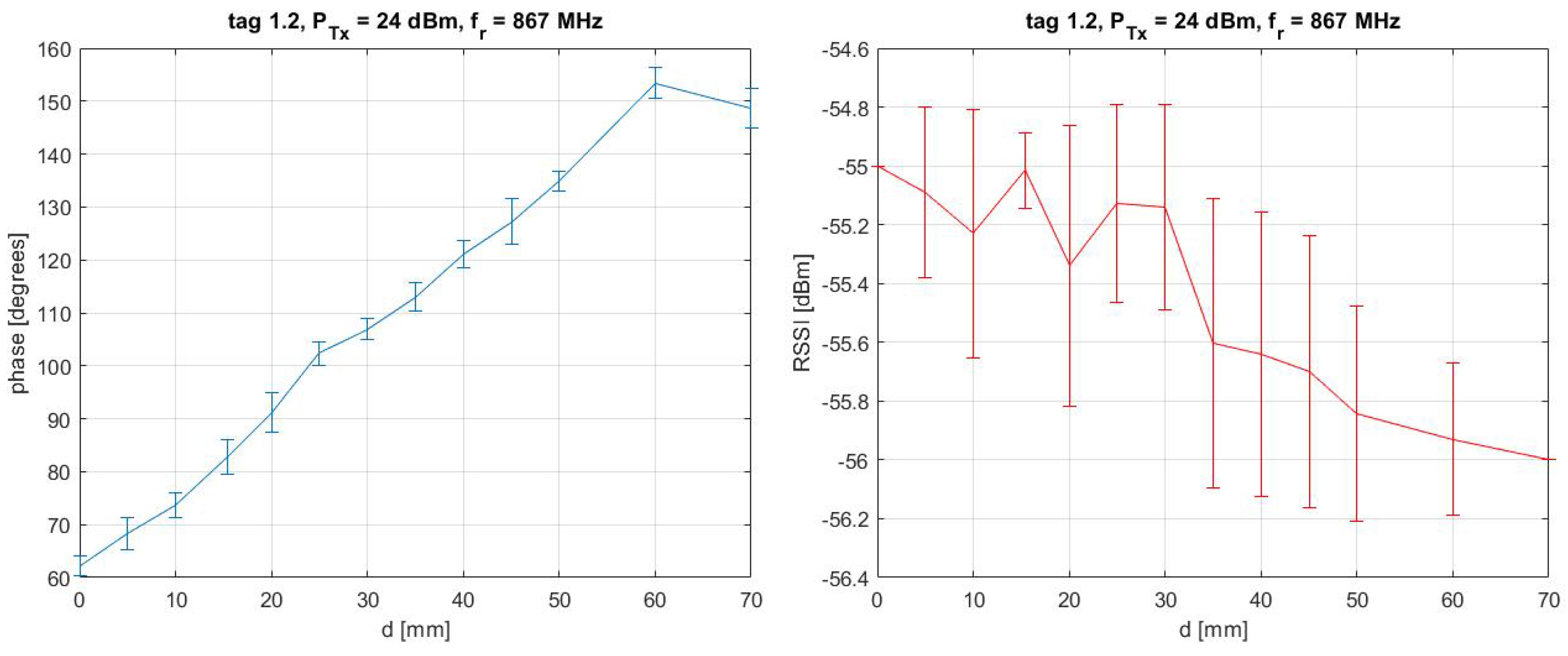


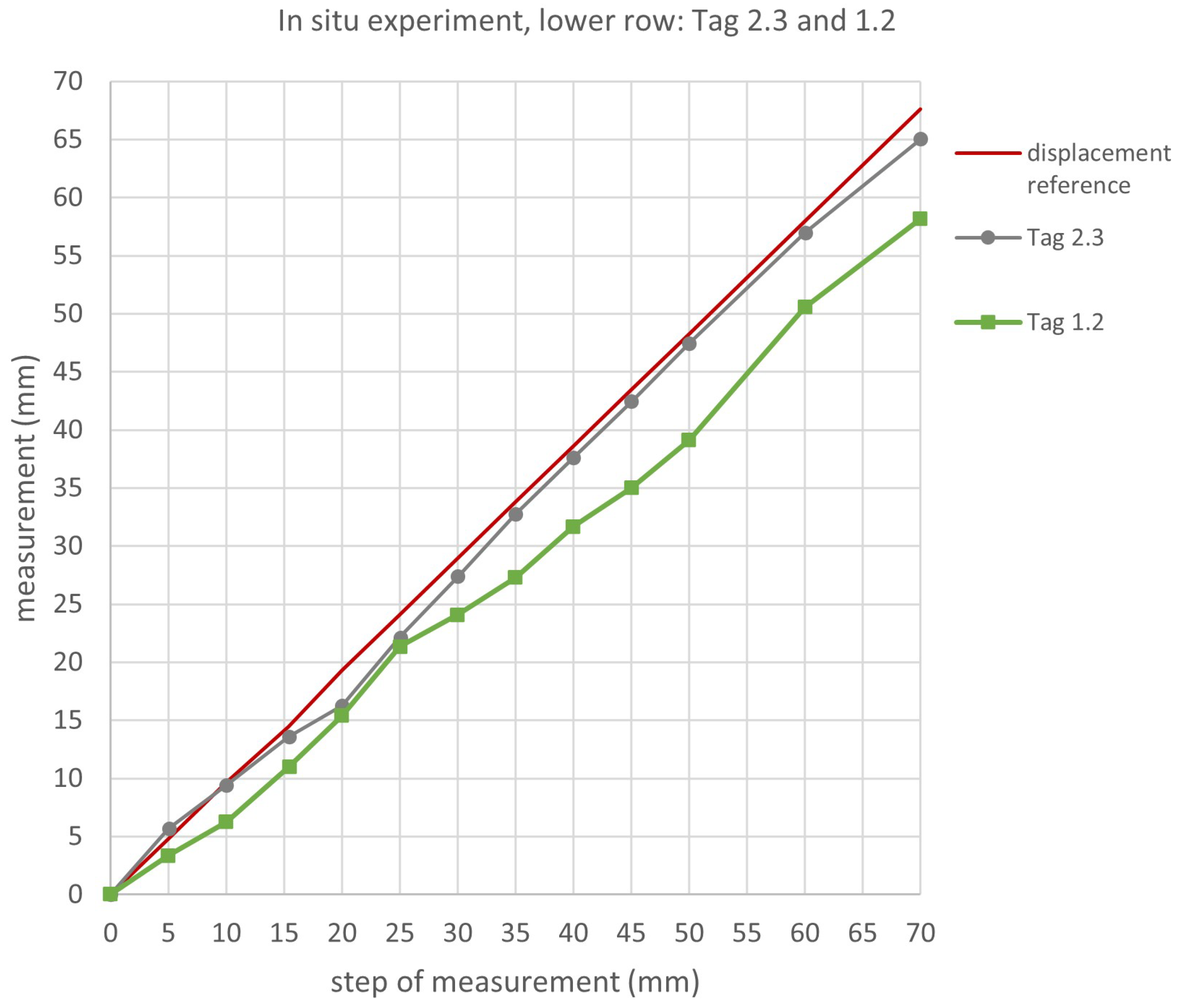
| Composition | Material | Thickness [μm] |
|---|---|---|
| Top | Aluminum | 9 ± 5% |
| Support | Polyester PET | 38 ± 5% |
| Tag | Operating frequency | Operating temperature |
| 840–960 MHz | −40 °C to +85 °C |
Disclaimer/Publisher’s Note: The statements, opinions and data contained in all publications are solely those of the individual author(s) and contributor(s) and not of MDPI and/or the editor(s). MDPI and/or the editor(s) disclaim responsibility for any injury to people or property resulting from any ideas, methods, instructions or products referred to in the content. |
© 2024 by the authors. Licensee MDPI, Basel, Switzerland. This article is an open access article distributed under the terms and conditions of the Creative Commons Attribution (CC BY) license (https://creativecommons.org/licenses/by/4.0/).
Share and Cite
Gregori, A.; Castoro, C.; Mercuri, M.; Di Natale, A.; Di Giampaolo, E. Innovative Use of UHF-RFID Wireless Sensors for Monitoring Cultural Heritage Structures. Buildings 2024, 14, 1155. https://doi.org/10.3390/buildings14041155
Gregori A, Castoro C, Mercuri M, Di Natale A, Di Giampaolo E. Innovative Use of UHF-RFID Wireless Sensors for Monitoring Cultural Heritage Structures. Buildings. 2024; 14(4):1155. https://doi.org/10.3390/buildings14041155
Chicago/Turabian StyleGregori, Amedeo, Chiara Castoro, Micaela Mercuri, Antonio Di Natale, and Emidio Di Giampaolo. 2024. "Innovative Use of UHF-RFID Wireless Sensors for Monitoring Cultural Heritage Structures" Buildings 14, no. 4: 1155. https://doi.org/10.3390/buildings14041155








